HORDERN HOUSE
RARE BOOKS · MANUSCRIPTS · PAINT INGS
July 2023


July 2023

1. ASHTON, Julian Rossi.
Shipping on the Yarra, Early Morning.
Watercolour on paper, 355 x 540mm, mounted and framed; signed lower right. Melbourne, circa 1880.
A lovely example of Ashton’s atmospheric watercolours, illustrating his sensitive use of colour and light; the steam ships and the warehouses beyond are painted delicately at sunrise when the light is especially soft, whilst the Yarra River is bathed in a shimmering glow of subtle colour. This was one of six works that Ashton exhibited in the tenth exhibition of the “Victorian Academy of Arts” in 1880. Catalogue number 117 was, “Shipping on the Yarra, early morning”. All his works drew high praise: “In each the artist has succeeded in exhibiting comparatively common place objects under a poetic aspect, without doing violence to nature; and in all he proves himself to have a remarkably fine eye for colour”

Julian Rossi Ashton (1851-1942) had exhibited at the Royal Academy of Arts, London before emigrating to Australia in 1878. He lived in Melbourne for five years before moving to Sydney where he dominated the Sydney art scene for over fifty years as an artist, teacher and patron, founding the “Julian Ashton Art School” in 1890. His early European training with the Academie Julien in Paris and at the West London School of Art encouraged French realism in the style of the Barbizon School with its emphasis on “en plein air” painting. Later, as a trustee of the Art Gallery of New South Wales, Ashton became an avid promoter of Australian Impressionism. In the magazine “Home” (March 1924)
Arthur Jose named him as one of ‘the seven greatest living Australians’ and in 1930 he was made a Commander of the Order of the British Empire Provenance: Probably Victorian Academy of Arts Exhibition, Melbourne April 1880, (catalogue no. 117). Private collection, Melbourne
$17,500 [4504885 at hordern.com] see description and illustrations at

Illustrated astronomy manuscript.
Octavo, 440 numbered pages including some blank sheets, with 4 mounted portraits en grisaille of Flamsteed, Roger Long, Laplace and Lalande, plus a mounted stipple-engraved portrait of Nevil Maskelyne, plus a total of 45 further full-page pen & ink illustrations, mostly with blue or sepia wash, illustrating the moon, star system, etc., the neatly-written text including table and calculations, plus a section entitled ‘To Bring a Transit Instrument into the Meridian by Gavin Lowe of Islington’, signed and dated by the author; with contemporary bone set square by W. & S. Jones, 30 Holborn, London, in pocket to front pastedown, contemporary diced calf with gilt silver clasps, gilt-titled ‘Stellae’ to spine, London, 1811.
This charming astronomical manuscript epitomises the strong intellectual interest in natural sciences in the later Enlightenment. The intricate presentation of manuscript data, the expertise in illustration, and the intellectual rigour shown in the composition of this Album, display Pelerin’s advanced understanding of astronomy.
Clearly a member of London’s intellectual movement of the later Enlightenment, Henry Ferdinand Pelerin was a London merchant of Huguenot background who married Sarah Ann Dawes in London in 1798 and was naturalised by private statute in the same year: “Henry Ferdinand Pelerin, of the Parish of Saint James, Westminster, in the County of Middlesex, merchant, son of Henry Pelerin, by Anne Elizabeth his wife, born at Hodimont in the Parish of Vender, in the Province of Limbourg in the Austrian Netherlands”. He became a member of the RSA, the Royal Society of Arts, then fully titled the Royal Society for the Encouragement of Arts, Manufactures, and Commerce, whose aim was “to embolden enterprise, enlarge science, refine art, improve our manufacturers and extend our commerce”. He appears in their lists of members with various addresses (in 1799 he was at 7 Lower James Street, Golden Square; in 1800 at 12 New North Street, Red Lion Square; and from 1803 to at least 1808 at 32 Essex Street, Strand).
He was at some time based at Lloyd’s coffee house, the well-attended venue where men would meet for conversation and commerce which ultimately became the massive insurance market. We know that he was there as, sadly, the notice of his bankruptcy in June 1822 described him as an insurance broker of “Lloyd’s Coffee House, in the City of London”. The coffee house aspect of Lloyd’s would suit what we can deduce from his manuscript – that he was an intelligent man with an enquiring mind and a scientific brain – since traditionally the coffee houses offered a venue where men met to discuss politics, fashion, current events, and to debate philosophy and the natural sciences. Historians often associate English coffee houses, during the 17th and 18th centuries, with the intellectual and cultural history of the Enlightenment.
$22,500 [5000255 at hordern.com] see description and illustrations at
RARE ORIGINAL VIEW IN MAURITIUS BY ONE OF BAUDIN’S ARTISTS
Original drawing of a scene in Mauritius…
Pencil sketch, 135 x 195 mm.; laid down on the original blue-paper mount, signed on the lower left of the mount and captioned. Mauritius, 1801-1803.

A striking pencil sketch by the Baudin voyage artist Milbert, done in the south-west of Mauritius after he had jumped ship from the Géographe on Baudin’s expedition to Australia and the Pacific in 1801.
Jacques-Gérard Milbert (1766-1840) had joined the Baudin expedition as one of the official artists but took advantage of an illness to be left in Port Louis when the ships sailed for New Holland (several of his shipmates commented that the artist had seemed depressed and anxious about the voyage). In a curious twist, he was still in Port Louis when the Géographe returned from Australia in 1803, and rejoined the expedition.
Back in France, Milbert was given the task of overseeing the publication of the plates for Péron and Freycinet’s official account (1807-1816), and also wrote his own companion account, the Voyage Pittoresque of 1812, a work of great significance for the natural history of the region, in which he described himself as both a Baudin artist and the “directeur” of engravings.
In his book Milbert wrote that during his time on the island he made two long expeditions in the south-east, and was overawed by the rugged wonder of the landscape, particularly in the locality of the present scene, along the small and remote Rivière du Tamarin with its “plusieurs cascades magnifiques.” He poetically recounted how in the region one travelled to the sound of the blows of the axes clearing a path through the liana which enveloped the trees, and how many of the larger trees appeared to have been thrown down by nature to serve the weaker and parasitic vegetations, and to nourish them in the otherwise barren earth: as a description of the present scene this could scarcely be bettered.
The sketch showcases Milbert’s particular skill in rendering botanical scenes and makes an important addition to the rather slender group of known works by him, particularly relating to his time in the Indian Ocean. Of the three men in the clearing, the seated figure at far left in a hat is likely to be Milbert himself, given that a similar figure with a palette also appears in many of his finished engravings.
On an intimate scale and full of botanical detail, this sketch makes a fascinating counterpoint to the great engraved views of his book, most obviously one showing the main waterfall at the nearby “Cascade du Tamarin”, but also to several others which show slaves labouring to fell trees and mill logs.
Provenance: North American source, believed to derive from the same original source as a Lesueur drawing described by us elsewhere and to have been among the archive left in America by Milbert.
$12,500 [4504851 at hordern.com] see description and illustrations at
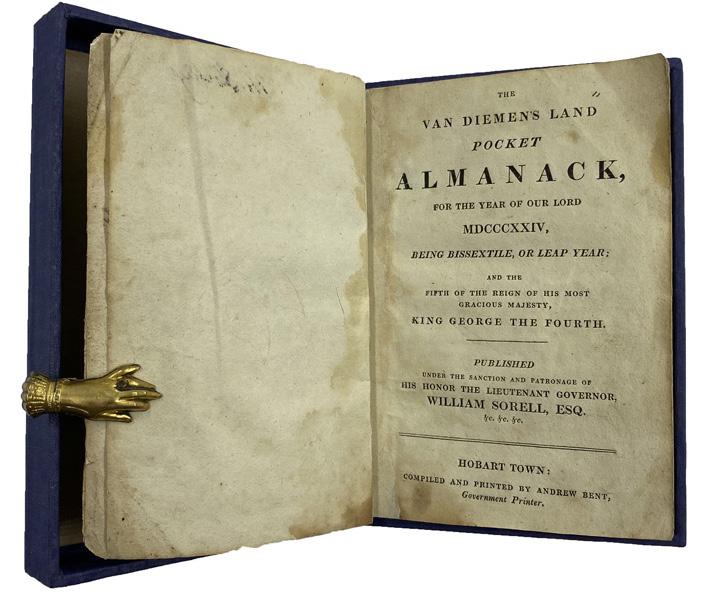
The Van Diemen’s Land Pocket Almanac for the Year of Our Lord MDCCCXXIV…
Duodecimo, 96pp; old limp card wrappers, neatly rebacked, and preserved in a blue cloth book form box. Hobart Town, Andrew Bent, 1824.
The first Tasmanian almanac and extremely rare: an historical, first-hand account of Tasmanian cultural, economic and social mores compiled by an intelligent observer, a founding father of the Australian free press. Described by Ferguson as “extremely rare”, this copy of the important almanac comes from the celebrated, handpicked collection of the late Quentin Keynes.
Besides the Keynes copy offered here; the earliest sale record is recorded at 988 by Ferguson; “a copy was offered by the Museum Book Store London for twenty five pounds (catalogue 114, item 611 1929)”. Furthermore, a full page illustration of the title page can be seen in volume one opposite page 362. Over the past 50 years only four further copies have come to light.
Andrew Bent, printer, publisher and newspaper proprietor, is celebrated for having established the first successful newspaper in Tasmania, the first Australian newspaper to be printed free from government control. Ironically, that freedom would lead to him becoming the first Australian publisher to be imprisoned for libel.
Bent’s first almanac is an atmospheric gem, discussing over fifty separate subjects that encompass colonial life and news for the inhabitants in the burgeoning colony. The Colonial Gardening section has a chapter on The Fruit Garden that reports “the produce of grapes in this country is astonishingly great, and they are exceedingly fine in quality; and this fruit will no doubt in the course of a few years be of considerable benefit to the colony, not only for making wines for our own consumption, but for exportation…” (p.31).
Bent arrived in Hobart in February 1812 after being charged with breaking and entering whilst still a teenager at Newgate prison in 1810. The harsh sentence was transportation for life to Australia. By 1815 his considerable skills as a printer were recognised, and he was appointed the Government Printer, soon receiving a conditional pardon with an absolute pardon following in 1821.
On Governor George Arthur’s arrival in Hobart in May 1824 Bent’s situation took a turn for the worse
as the Governor saw no place for a free press in a convict colony. Bent fought strongly for permission to continue and indeed his claim was supported by the New South Wales. Governor Thomas Brisbane.

On 8 October 1824 the Hobart Town Gazette announced Bent’s victory in an article which referred to Arthur as a ‘Gideonite of tyranny’. This comment began years of disquiet and struggle for Bent against his protractors employing vengeful attempts to stop Bent’s newspaper ‘continuing to be the tool of a faction’. (Woodberry, 1972).
E. M. Miller wrote that “Andrew Bent is worthy of remembrance for his indomitable fight for the freedom of the press in Tasmania, and for his exceptional typographical productions in the form of newspapers, magazines, books and pamphlets, including the first literary works separately published in Tasmania”. In 2018, Andrew Bent was inducted into the Australian Media Hall of Fame.
Provenance: An early inscription and occasional manuscript entries in an unidentified hand; Quentin Keynes (Christie’s London, 2004).

Ferguson, 988; Wilson, 229.
$26,500 [5000859 at hordern.com] see description and illustrations at
First on the Antarctic Continent…
Octavo, with photogravure portrait frontispiece, three coloured maps (folding), 18 plates and numerous photographic illustrations; an excellent copy in the original red cloth variant binding. London, George Newnes, 1901.
The second issue of the first edition, issued in the same year, and identified by its red cloth binding. This was the leader and organiser’s account of the Antarctic cruise of the Southern Cross, the first expedition to winter on the Antarctic continent. The Norwegian-born Borchgrevink migrated to Australia aged 24 years. He was a member of Henrik Bull’s Norwegian expedition on the Antarctic, which completed the first confirmed landing on the Antarctic continental mainland in 1895. On his return, Borchgrevink began planning for an expedition to reach both the Magnetic and South Poles. He travelled to England to raise sponsorship and eventually convinced the publisher Sir George Newnes to back the project, with his purchase and refit of the Southern Cross. Consequently, Borchgrevink and a party of nine other men and 75 sledge dogs were the first to make winter camp on the Antarctic mainland. The inhospitable conditions prevented the expedition achieving their goals, however they did successfully complete the first sledging journey across the Ross Ice Shelf and reached a new furthest south, exceeding Ross’s earlier benchmark set in 1840. By proving that a party could winter safely on the ice, they laid the groundwork for the Antarctic expeditions which followed.

The Southern Cross expedition could claim a number of “firsts” in Antarctic exploration, including having been the first to establish a base to winter over on the continent. Louis Bernacchi and Will Colbeck were amongst the expedition members, one of whom, Nikolai Hanson, died, and was the first person to be buried on Antarctica. Rosove calls it “one of the most important in the Antarctic bibliography”.
Renard, 153; Rosove 45.A1.b ‘Considerably scarcer than [the first issue]’.
$1650 [5000550 at hordern.com] see description and illustrations at
6. CICERO, Marcus Tullius.
Various works contained in eight volumes…
Eight separately published works, octavo, bound as a most handsome set in English red morocco, spines gilt in compartments and lettered with name of the work, the editor’s name and the place and date of publication, the bindings by Charles Lewis. Cambridge and Oxford, various publishers, 1718-1727.
A fine set of works by Cicero, assembled by the collector Henry Drury, uniformly bound for him, each work collated by him with his typically neat note, in slightly differing words in each volume, “Charta maxima [i.e. Large Paper]”, dated at Harrow in 1819. In one volume Drury notes that they were acquired “from Mr Williams’s collection, at Hendon”. In each volume he identifies its binding as being by Lewis, that is the famous English binder Charles Lewis, who worked from 1807.

Henry Joseph Thomas Drury (1778-1841) ws a fellow of King’s College, Cambridge from 1799 to 1808, thereafter Under Master and then Master of the Lower School at his alma mater Harrow. He had a great reputation as a classical scholar, was an original member of the Roxburghe Club, and memorialised as Menalcus in Dibdin’s Bibliographical Decameron. His formidable library of Greek and Latin classics was dispersed in 4729 lots over 23 days in February and March 1827.
At Drury’s sale in 1827 they were bought by an unknown collector whose note tipped into one volume reads “H. Drury’s Sale 23 February 1827. Cicero 8 vo. Ch. Mxma. L11.6.0. Nos. 861, 871, 72, 73, 74, 75. Bound by Cha. Lewis”.
The sale catalogue entries for those lots are as follows:
861 Ciceronis Omnes, qui ad artem Oratorium pertinent, Libri, ed. J. Proust, 3 vols, Oxford, 1718
871 Ciceronis Tusculanae Disputationes Libri V, ed. Davis, Cambridge, 1723
872 Cicero de Divinatione et de Fato, ed. Davis, Cambridge, 1721
873 Ciceronis Academica, ed. Davis, Cambridge, 1725
874 Cicero de Nature Deorum, ed. Davis & Walker, Cambridge, 1718
875 Cicero de Legibus, ed. Davis, Cambridge 1727
The first, three-volume, work was edited by J. Proust, while the others were all edited by Davis.
A catalogue of the extensive and valuable library of the Rev. Henry Drury… Which will be sold by auction, by Mr. Evans… on… February 19. And eleven following days; and… March 12, and ten following days (Sundays excepted). 1827, lots 861 and 871-75.
Provenance: Henry Drury, with his notes in each volume.
$2750 [5000811 at hordern.com] see description and illustrations at
7. COOK, James.
Autograph letter signed.
Autograph manuscript in ink on paper, on one side of a single sheet, small folio, amounting to about 12 lines, with a fine signature by Cook; docket-title on verso in a different hand. HMS Resolution at Deptford, 9 March 1772.
Extremely rare: a full letter, written entirely by Cook and signed boldly by him. The letter was written aboard HMS Resolution while the ship was at Deptford, taking on final stores and provisions prior to sailing on Cook’s arduous second voyage.
In the letter, dated 9 March 1772 and addressed to an official of the English East India Company, Cook asks for the release of one of his men who has been press-ganged into the company’s service. Such a letter, written without the assistance of one of Cook’s indefatigable clerks, is particularly rare and attractive, especially as the main corpus of material regarding his preparations for the second voyage takes the form of official correspondence, frequently terse, dealing with more conventional subjects.

The letter reads, in full:
Having received a letter from James Keaton belonging to His Majesty’s Sloop Resolution under my command, acquainting me with his being inticed on board the Devonshire belonging to the Hon. East India Company, and there detain’d to serve as a soldier, I beg you will order him to be discharged or delivered up to such persons as I shall send for that purpose. I am
James Cook
To Mr. Coggin
The activities of press-gangs at this period are well known and were a considerable hazard to a captain preparing to embark. This was especially true in 1772 for Cook, who was enduring lengthy enforced delays in his preparations for the second voyage. Indeed, a great many sailors were known to have “run” from the Resolution in the long months while the two vessels were going through their refit, with an incredible fifty-eight recorded as having thus absconded, and another thirty-nine discharged for various reasons (see John Robson’s online database).
The depth of research that has been done regarding Cook’s musters makes this manuscript document of especial interest, as James Keaton is not otherwise known to Cook historians (the similarly named “John Heaton” is
recorded as running at the Nore on 14 May 1772, but Cook’s hand is clear and the dates irreconcilable). It is also interesting that Keaton, in Cook’s words, has been taken ‘as a soldier’, as his detachment of marines did not come aboard until 29 April 1772. Despite the bustle of Deptford, it would seem that Cook was well informed about the fate of Keaton, as the 499-ton East Indiaman Devonshire, captain Robert Morgan, was very likely in port; she later sailed from Portsmouth on 12 April 1772 (see Charles Hardy, A Register of Ships, Employed in the Service of the Honourable the United East India Company, p. 55).

The letter is addressed to “Mr Coggin”, undoubtedly a homophone for “Coggan”, and almost certainly Charles Thomas Coggan, one of the directors of the East India Company and Comptroller of Shipping. Coggan went on to a long and illustrious career in the company, and by 1811 was the company’s paymaster.
The letter is not recorded in Beaglehole’s calendar of documents for the second voyage, although he does note three other letters apparently of the same day, two to the Victualling Board and a third to Banks, at a time when the naturalist was still intending to sail. Moreover, while Beaglehole lists no fewer than ninety-two letters from Cook before he sailed on 13 July 1772, almost all of this material is quite boilerplate in form, mostly addressed to the Admiralty, or to official bodies such as the Victualling or the Navy boards. Other than the present, urgent example the only letters not taking on a formal cast are one to Cook’s friend Captain William Hammond, two to Joseph Banks, and a few to Cook’s fellow officers on the Resolution or Adventure. Unlike most of the letters from this period, and presumably because Cook wrote it himself in haste, the text of this letter was never copied into the ship’s record (as would normally have been done by his clerk) and thus does not appear in the Canberra Letter Book (1771-1778).
This wonderful manuscript originally appeared for sale in the London dealer Francis Edwards’ catalogue 904 (1967, item 96, priced £330: in the same catalogue a copy of Magra’s surreptitious account of the first voyage was priced £95). The export licence attached to the letter shows that it was sold to R.C. Bedell of Columbia, Missouri.
Beaglehole, II, pp. 896-965 (Calendar of Documents), and passim.
Provenance: With Messrs Francis Edwards in 1967 (their catalogue 904, item 96); sold to R.C. Bedell (private collector of Columbia, Missouri); acquired by Robert Parks (private collector of Detroit, Michigan); with Hordern House (catalogue “Captain James Cook, the Greatest Discoverer. The Robert and Mary Anne Parks Collection”, 2008, item 34); private collection (Australia).
$425,000 [5000783 at hordern.com] see description and illustrations at
Octavo, two hand-coloured plates and seven hand-coloured maps (four double-page, three folding), a handsome copy. Paris, Chez Saintin, 1811.
A charming children’s atlas, with delightful depictions of Tahiti, New Zealand and Hawaii. Although much reprinted and very popular, this work is now rare in any edition. Two exquisite plates, each with twelve small vignettes, detail the peoples of the world. The first three main panels show images of European, Asian, and African scenes, while the fourth has ‘American’ images; there are not only charming images of Iroquois, Californians, and Peruvians, but surprisingly the three final scenes show New Zealanders, Tahitians and inhabitants of the Sandwich Islands (here accidentally called “Americans”, almost a century before their formal annexation). Each of the vignettes is also vouchsafed a very brief note, with some unusual commentary: we learn that the New Zealanders love their children, that the lower-caste Hawaiians prostrate themselves on the ground before royalty, and that the only quadrupeds in Tahiti are dogs, cats, and rats.
The series of maps is equally interesting, with good depictions of France, Europe, Africa and the Americas. There is also a large double-hemisphere map of the globe by Blondeau: New Holland is shown still attached to Van Diemens Land, and the Pacific Islands are represented in some detail, showing the Society Islands, the Marquesas, and the Friendly Isles. The Sandwich Islands are also clearly marked, with the familiar caption that ‘here Captain Cook was killed’.

Saintin was a publisher of popular editions of authors such as Moliere and Homer, and issued several such works of geographical instruction.
Gumuchian, 5087 (1810 edition); not in Forbes.
$2850 [3702899 at hordern.com] see description and illustrations at
9. COX, David.
A Series of Progressive Lessons intended to Elucidate the Art of Painting…
Oblong quarto; illustrated throughout with full-page hand-coloured lithographs; in later quarter maroon calf over original marbled boards. London, T. Clay, 1828.
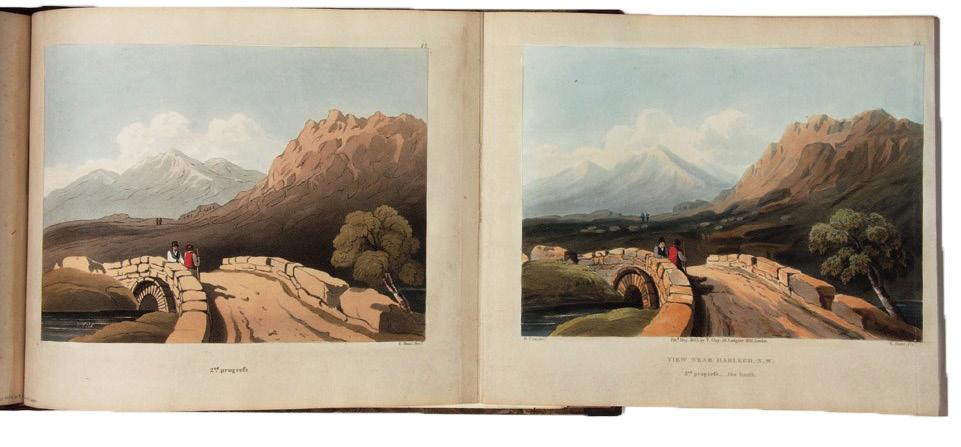
Artistic tuition by a notable English painter whose reputation has grown in recent years. An exhibition of Cox’s work at the Yale Center for British Art, with a substantial accompanying reference work, has drawn further attention to a painter who, although somewhat out of fashion in recent decades, has often been compared with Turner, Constable and Burne-Jones.
Cox’s work includes studies on perspective, sketching, shading and marine art. The illustrations are prepared in lithography and coloured by hand, and some of the larger plates are folding. The ability to draw topography was seen as an important skill for naval and military officers, having obviously important practical applications and often being taught to cadets from a young age. Although this manual is rather advanced for military purposes, it would have been of particular interest to the often military men who drifted into landscape painting and found a ready audience for publication of their illustrations of exotic travels.
‘Cox’s work was praised by Thackeray in Sketches after English Landscape Painters (1850) and Ruskin wrote in 1857 that “there is not any other landscape which comes near these works of David Cox in simplicity or seriousness”. Although Cox’s standing in the art world reached its apex in the late 19th century, recent reappraisals of Victorian art have seen Cox rightly restored to his position as one of the finest of all British landscape painters…’ (National Library of Scotland).
$2100 [3806703 at hordern.com] see description and illustrations at
The Exotic Gardener…
Octavo; a good copy in contemporary calf, neatly rebacked. London, Printed by A. Macpherson, 1812. First London edition, and a work of great interest to Australian horticulture: this is the first book to include instructions on growing Australian plants, here usually referred to as ‘Botany Bay plants’.
‘It includes Australian plants among its exotics and is the first gardening guide for growing such plants. Many members of the First Fleet sent back seeds to their friends in England… and for many years settlers did likewise. Daniel Bunce in Hobart Town advertised seeds of native plants for sending to friends in Britain. The Exotic Gardener, therefore, represents the first recommended use of Australian native plants for the garden or more likely the greenhouse or conservatory’ (Victor Crittenden, A History and Bibliography of Australian Gardening Books, pp. 11-12).
The work is full of practical advice on the generally hard-wooded plants of Australia, with particular notice of the varieties of Banksias. Cushing recommends a loamy, sandy soil for the Botany Bay plants, and notes that any seeds received from New South Wales, as with those of the South Sea Islands generally, will require the aid of a hot-bed when first sown.
Crittenden, ‘A History and Bibliography of Australian Gardening Books’, 2 (1814 edition).

Provenance: William Case (early signature at head of title).
$3800 [5000778 at hordern.com] see description and illustrations at
11. DAMPIER, William.
A set of Dampier’s voyages, complete to 1703 with the publication of the “Voyage to New Holland”. Three volumes, octavo, with altogether 14 engraved maps and 10 plates and tables ( the first volume with 5 maps (4 folding); 2nd volume with 4 (folding) maps; 3rd volume with a folding map and14 plates.); contemporary panelled calf, the spines panelled in gilt in six compartments between five raised bands, red leather labels. London, James Knapton, 1699, 1700, 1703.
1. “A New Voyage round the World…”. Fourth edition, 1699, corrected from the first edition of 1697. The first account of the first English landing in Australia.
2. “Voyages and Descriptions Vol. II… A supplement to the Voyage round the World…”. Second edition, 1700.

The continuation of Dampier’s New Voyage, described as Volume II on the title-page but quite separately published.
3. “A Voyage to New Holland, &c. in the year, 1699…”. First edition. The important and rare first edition of the first deliberate English voyage to Australia, one of very few classic pre-Cook voyages to the continent.
A very attractive set of Dampier’s voyages, in contemporary bindings and with excellent provenance, complete to the publication of the “Voyage to New Holland” (but before publication of the separately-published continuation of 1709). Most sets of Dampier’s voyages are examples of the much later compilation edition of 1729 and sets composed of the original printings are desirable.
These classic voyage narratives by England’s most famous buccaneer represent a major body of early Pacific description, including the first landing by an Englishman in Australia, and the first deliberate English voyage to Australia, one of very few classic pre-Cook voyages to the continent.
Widely regarded as the greatest English explorer and navigator before Cook, Dampier was also a popular and exciting writer. His books went through many editions - indeed he is still in print in one
HORDERN HOUSE hordern.com
form or another - and copies of the early editions of his voyages have always been difficult to find. In 1729 his publishers made an effort to continue sales by establishing a uniform version, but even in the early nineteenth century the books were rare: Burney noted in his collection of Voyages (vol. IV, p. 486) that “Many editions of Dampier’s Voyages have been printed, and they have been so fairly worn out that at this time it is difficult to procure a complete set…”.
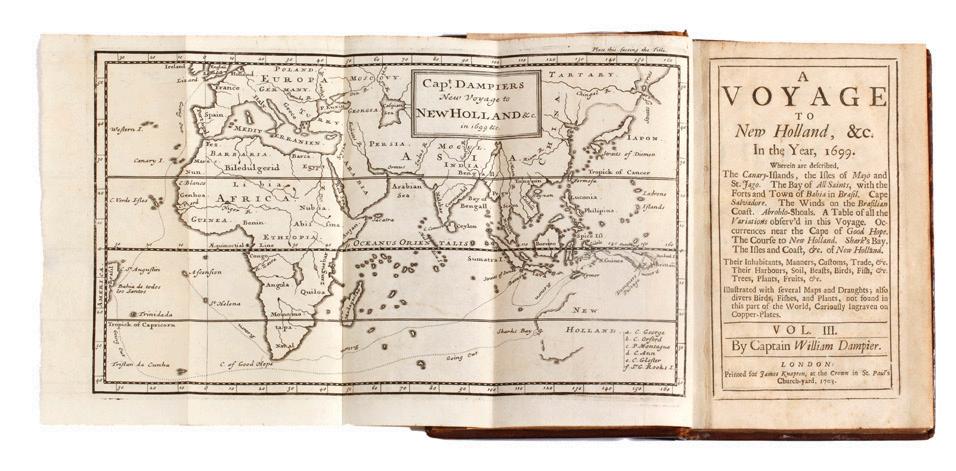
Provenance: With the armorial bookplate in the first and second volumes of William Cowper, 1st Earl Cowper, (1665-1723), English politician and the first Lord High Chancellor of Great Britain following the Union with Scotland; the third volume has the small bookticket of Judith Cowper (over traces of the armorial bookplate of the other two volumes). Judith Cowper was probably the Cowper relative and poet (1702-1781), protégé of Alexander Pope, who became Judith Cowper Madan on her marriage in 1723.
$17,850 [5000817 at hordern.com] see description and illustrations at
Borba de Moraes, pp. 242-3; European Americana, 699/58 (for first two volumes) and 703/39; Hill, 417, 419 (different editions), and 420; Sabin, 18374-6; Wing, D164 and D166.The Posthumous Papers of the Pickwick Club.
Twenty numbers as published, in the original nineteen monthly wrappered octavo parts; forty-three inserted engraved plates, including frontispiece and vignette title-page; original green printed wrappers designed by Seymour; in a custom-made quarter morocco case. London, Chapman and Hall, 1836-1837.
A most attractive set of Pickwick in original parts, well-preserved by a series of owners, and in unsophisticated condition.
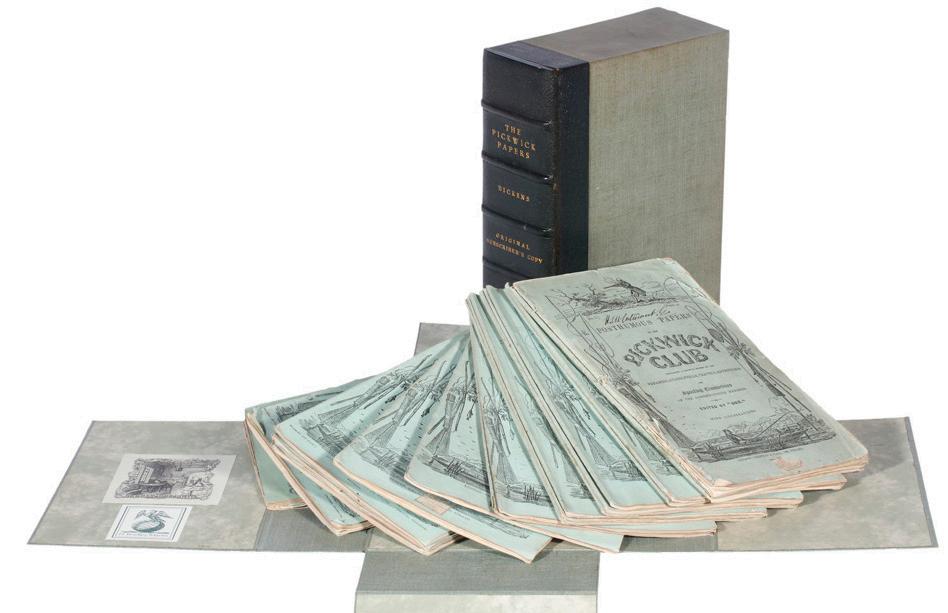
Collation of a Pickwick in parts is famously laborious. There are often multiple varying states or issues of individual components, whether text, engravings, wrappers, or advertisements. Changes were made to engravings as they were reprinted, sometimes because the plates wore out, errors in the text were corrected, and changes to the wrappers were frequent to revise the advertisements that they included.
Suffice to say of this set that, as with most, it is made up from different states. What is important is its impeccable original condition, as sold by the Belfast bookseller Hodgson, probably to H.W. Calmount who has boldly signed each part (presumably a Dublin reader, since there is a Calmount Park in Dublin).
The exhaustive description by Hatton and Cleaver is recognised as the standard bibliographical analysis: a full collation has been prepared of the present set. In summary: Parts I-XIII are in the later or reprinted wrappers with the others in the primary wrappers. The plates are mostly in their later states (where priority is distinguished) until the tenth part, after which they are a mixture of first and second states. Most texts are in their corrected later state. Four of the seven inserted “address leaves” by the author and publisher are present. (Also present are Calmount’s copies of “Illustrations to the Pickwick Club… by Samuel Weller” (E. Gratten, 1837) parts I & II, in the original green wrappers).
Nowadays, as it should be, as much attention is paid to the coherence of a set and to be able to show, as with this one, that there has been no sophistication attempted. The set is as issued, as purchased serially by its first owner, and in original condition.
Hatton & Cleaver, 3; Eckel, p.17ff.
Provenance: Hodgson, Belfast bookseller (small label on most front wrappers); each front wrapper inscribed at head “H.W. Calmount”; Arnold Greenhill (pictorial bookplate); H. Bradley Martin (emblematic bookplate, sale Sotheby’s New York, 30 April 1990, lot 2766, $6,000); private collection (Australia).
$16,500 [5000624 at hordern.com] see description and illustrations at
The Posthumous Papers of the Pickwick Club.
Octavo, lithographed frontispiece, additional lithographed title-page with vignette, and 18 lithograph plates (variants all in Craig’s “A” state), as usual without the half-title and two leaves of inserted terminal advertisements (issued in only a few copies); the plate at p. 95 with lower outer section (less than a quarter of the image) supplied in good facsimile); contemporary half calf. V.D. Land: Launceston, Henry Dowling, 1838 [-1839].
The famous Tasmanian Pickwick. Capitalising on the huge demand for the London printing of Dickens’ Pickwick Papers, the Launceston printer Henry Dowling decided to pirate the edition and release it in parts as they became available throughout 1838 and 1839. The story of its publication is dealt with at length by Clifford Craig, in The Van Diemen’s Land Edition of the Pickwick Papers (Hobart 1973), who describes the book as ‘one of the most coveted books sought after by the Australian collector’. It is a rarity in collections of Dickens in Europe and America.
The illustrations were offered for sale after the publication in parts was complete, and were used for finished volumes like this. They have generally been attributed to either Jack Briggs, who was a servant of the publisher, or Wainwright, the poisoner,a skilled artist. More recent research, however, hypothesises that they may have been carried out by the colonial artist Robert Hawker Dowling, the publisher’s brother.
The title-page is dated 1838 while the pictorial title-page is dated 1839.
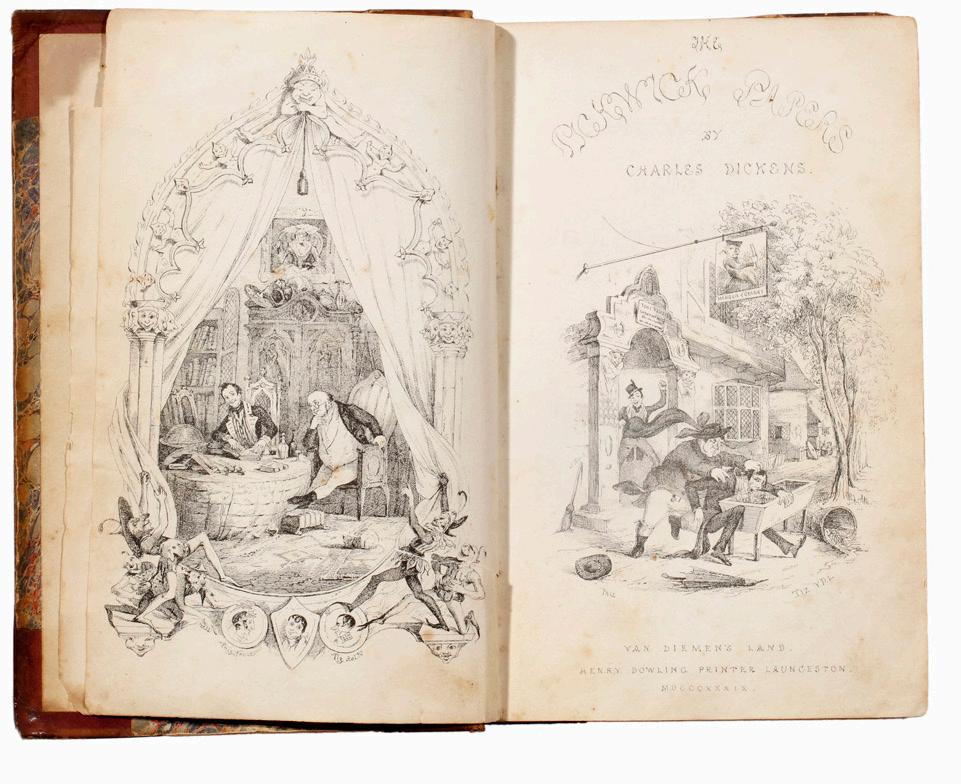
The lithograph plates in this copy are all examples of the ‘A’ variants identified by Craig (five plates, at pp. 76, 117, 233, 265 and 334 or 337, are known in two distinct versions which he identified as ‘A’ or ‘B’). A contemporary advertisement sang the praises of this “product of colonial industry… The obstacles which the Publisher has had to contend with in the production in this Colony [of the lithograph illustrations] can only be estimated by those who are familiar with the lithographic art…”.
Bremer, 355; Craig (Engravers), pp. 127-132; Craig (The Van Diemen’s Land Edition of The Pickwick Papers), passim, and pp. 24-44 for the variant plates; Ferguson, 2473; Kerr, pp. 804-5 and 217-9.
$9850 [5000623 at hordern.com] see description and illustrations at
HORDERN HOUSE hordern.com
Medal for the departure of the first voyage of the Astrolabe.
Bronze medal, 50 mm, Paris, Depaulis, 1826.


Rare original medallion commemorating the departure on 25 April 1826 of the first voyage of the Astrolabe to the South Seas, under the command of Dumont d’Urville.
The Astrolabe (Duperrey’s old ship the Coquille renamed in honour of La Pérouse) was instructed to explore the principal island groups in the South Pacific, completing the work of the Duperrey voyage, on which the commander had been a naturalist. The expedition sailed via the Cape of Good Hope, through Bass Strait, stopped at Port Phillip, and arrived at Sydney on 1 December 1828. They later sailed via the northwest coast of Australia to Tasmania, from where they proceeded to Vanikoro in search of traces of La Pérouse.
The full inscription on the reverse reads: “S.A.R. Monseigneur Le Dauphin, Amiral de France. M. Le Cte Chabrol de Crouzol, Pair de France, Ministre de la Marine. M. Dumont D’Urville, Captaine de Fregate, commandant ‘‘Expedition”.
Marquess of Milford Haven, ‘British and Foreign Naval Medals’, 190.
$3600 [3903104 at hordern.com] see description and illustrations at
Autograph letter signed to Mr. Chauvin…
Single sheet of laid paper, 207 x 260 mm., folded vertically to form a letter, written in a small and neat hand to first page and addressed – but not stamped – to the last, old folds; excellent. N.P., N.D., but circa 1832.
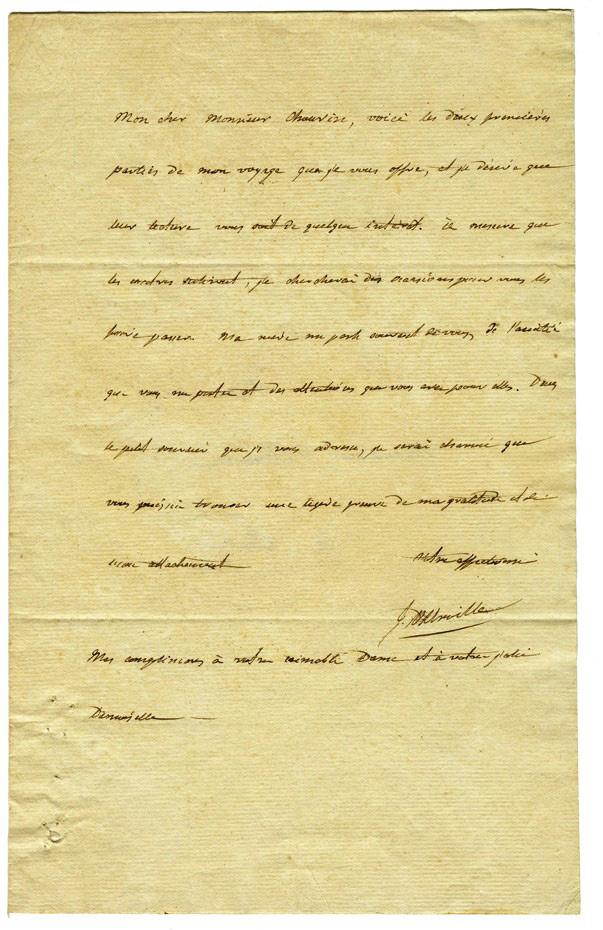
A significant letter in which the great Pacific and Antarctic explorer Dumont d’Urville presents the first parts of his official account of his first voyage to the natural historian F.J. Chauvin of Caen, active in botanical studies in the mid-nineteenth century. Chauvin’s herbarium is still held at the Université de Caen, and he is remembered by several plants named in his honour.
In the letter, Dumont d’Urville sends Chauvin the “first two parts” of his voyage account, in the hope that they will be of interest. It may be that he was sending the first parts of the historical narrative of the voyage, first published in 1830, but given Chauvin’s botanical studies, it seems more likely that he was being sent the two parts of the Botanie volume, edited by Lesson & Richard (I. Essai d’une Flore de la Nouvelle Zelande. II. Sertum Astrolabianum, Paris, 1832-4).
Dumont d’Urville had sailed on the Astrolabe (Duperrey’s old ship the Coquille renamed in honour of La Pérouse) from Toulon in April 1826. He was instructed to explore the principal island groups in the South Pacific, completing the work of the Duperrey voyage, on which the commander himself had been a naturalist. Because of his great interest in natural history, huge amounts of scientific data and specimens were collected, described and illustrated in sumptuous folio atlases. The expedition stopped at the Cape of Good Hope, passed through Bass Strait visiting Port Phillip, and arrived at Sydney on 1 December 1828.
Extensive visits were made to both Sydney and Parramatta, where Dumont d’Urville visited Samuel Marsden; the expedition sailed for New Zealand in January 1827, explored Tasman Bay, found a pass between an island in Cook Strait and the northern shore of South Island (the island consequently named D’Urville and the strait French Strait) and worked up the coast of North Island, completing the ‘most comprehensive exploration of the islands since Cook’s death’. They made Tonga in April 1827, explored the Fiji Archipelago, New Britain and New Guinea. In November, after a stop at Amboina, they coasted along the north-west coast of Australia and reached Tasmania. In 1828 they continued to Vanikoro in search of traces of La Pérouse, and stopped at Guam in the Marianas, before returning via the Cape of Good Hope, reaching Marseille on 25 March 1829.
$2800 [4002623 at hordern.com]
see description and illustrations at
HORDERN HOUSE hordern.com
16. [DUMONT D’URVILLE] SAINSON, M. de
Nlle. Hollande (Port du Roi Georges).
Two lithographs, one handcoloured, 340 x 540 mm (sheet). Paris, Tastu, 1833.
Rare: original lithographs, in both the coloured and uncoloured states, from the official account of the Dumont d’Urville expedition, Voyage de la corvette l’Astrolabe et la Zelee (1833).
Louis de Sainson, the topographical draughtsman travelling with the expedition, created a series of portraits depicting indigenous people he encountered in the places they visited. He made many detailed studies of the local inhabitants of King George’s Sound from 15 to 25 October 1826. King George’s Sound proved a perfect watering place for the expedition with an abundance of fresh water, firewood and a safe anchorage. These portraits aimed to document the physical appearances, dress, and customs of the indigenous populations they encountered. These artworks provide valuable historical and cultural insights into First Nations communities at the time of colonial settlement.


$2500 [5000876 at hordern.com]
see description and illustrations at
17.
Journael, ofte dach-register vande Voyagie…
Oblong folio, 28 pp.; bound in full dark-brown oasis. Amsterdam, Jan Jansz, 1645.

First edition of one of the first Dutch voyages across the Indian Ocean, published as one of the separate pieces that were also combined to make up Commelin’s voyage collection Begin ende Voortgangh. This is one of remarkably few printed references to the Duyfken, the tiny ship of huge importance to Australian history.
Harmensz was in joint command of the third major voyage by the Dutch to the East-Indies, the so-called Moluccan Fleet of 1601-1603 which set out to establish a new Dutch presence in the East Indies. The five ships reached Bantam, Java, at the end of 1601 where they were confronted by a substantial Portuguese fleet of thirty ships under the command of Andrea Fortade de Mendoça. Harmensz’s conquest of the Portuguese fleet marked a turning point in the history of the region, bringing to a close the domination of the Portuguese and Spanish in the Spice Trade to Europe.
Of special interest to us today is that one of the five ships of Harmensz’s fleet was the Duyfken, then under the command of Willem Cornelisz Schouten. This was her first voyage; returning to Europe in 1603, she was quickly turned round and came back to the East Indies in the fleet of van der Hagen with Willem Janszoon as skipper. She was sent separately to the southeast, and early in 1606, sailing alone, she coasted Cape York Peninsula, making the first authenticated sighting of Australia by Europeans, as well as the first authenticated landing of Europeans on Australian soil. In 1607, she may have made a second voyage east to Australia.
The famous replica of the ship, launched in 1999, is now permanently in the collection of the Australian National Maritime Museum.
Landwehr, ‘VOC’, 250 (9); Tiele, ‘Bibliography’, 1206; Tiele, ‘Mémoire’, 162.
$8500 [4401830 at hordern.com] see description and illustrations at
18. EARL, George Windsor.
The Eastern Seas, or Voyages and Adventures in the Indian Archipelago
Octavo, with four folding maps; a fine copy in full navy gilt morocco. London, William H. Allen and Co., 1837. A fine copy of this engaging account of travels in the East Indies, especially Java and the Malay Peninsula. The voyage that Earl describes started from Western Australia, and his appendix includes “Observations on the Unexplored Parts of North and North-Western Australia”. The most important section of the book is the long description of Singapore and discussion of its prospects.
Earl adds a 14-page article at the end, “Observations on the Unexplored Parts of North and Northwestern Australia”. Many years later he wrote the Handbook for Colonists in Tropical Australia (published Singapore 1862), a useful book in the settlement of the Northern Territory.
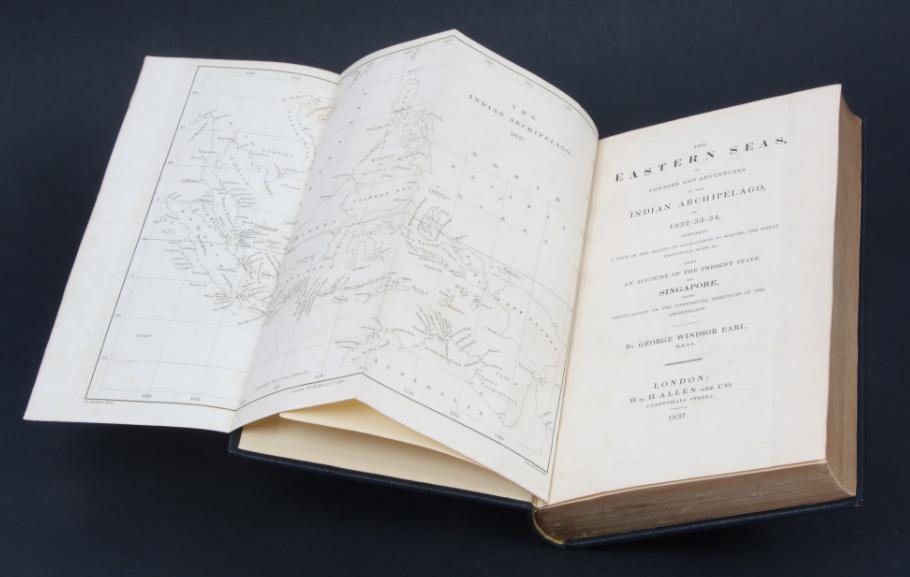
Cordier, Indosinica, 892-3; Ferguson, 2255.
Provenance: Geoffrey Ingleton (renowned Sydney collector, d.1998; with bookplate).
$2250 [5000841 at hordern.com] see description and illustrations at
HORDERN HOUSE hordern.com
Narrative of a Journey to the Shores of the Polar Sea
Two volumes, octavo, with four splendid folding maps; in contemporary navy blue half calf, marbled boards, edges and endpapers, spines ornately panelled in gilt with duble brown labels (lettered “Franklin’s Journey to the Copper Mine River”). London, John Murray, 1824.

A particularly fine set, in a most attractive contemporary binding, of the second, first octavo, edition: Sir John Franklin’s narrative of the 1819-1822 expedition to the polar north under his command. Assured of guides and ongoing supplies by the Hudson’s Bay Company, Franklin and his party of twenty men sought an overland route east of the Coppermine River. Using native canoes to traverse a vast landscape, relations among the men deteriorated as food and supplies dwindled. Cold, exposure and starvation took a harrowing toll as cannibalism and murder erupted amongst the voyagers. A total of nine men died.
This account was initially published in a lavishly illustrated quarto edition. This second edition in smaller format features four splendidly engraved maps. Franklin, who had served as a midshipman under Matthew Flinders in the Investigator during the circumnavigation of Australia in 1801-04, was later appointed as Lieutenant-Governor of Tasmania from 1837 to 1843. His reputation as an Arctic explorer and his search for the North West Passage grew in the following years, and culminated in the loss of the Erebus and Terror on his final expedition in search of the passage in June 1847.
$2100 [5000768 at hordern.com]
see description and illustrations at
Arctic Bib., 5195; Sabin, 25625; Staton & Tremaine, 1249.PROOF ZOOLOGICAL ENGRAVING BEFORE SIGNIFICANT EDITING
20. [FREYCINET VOYAGE] PREVOST, A; engraved by Jean Louis-Denis COUTANT,
“Kanguroo à queue grèle:” Proof engraving (before substantial changes) for plate 10 in the Atlas Zoologie of the Freycinet account of the Uranie voyage. Black and white engraving, 320 x 238mm. [Paris], [Langlois], 1824 or earlier.
Very rare early proof for an engraving of a potoroo in the zoological Atlas of the Freycinet voyage account: the engraving as finally published would include a further taxonomical detail in the form of added detail of the animal’s skull, titled “Son crâne”, and the caption would be entirely changed, renaming the animal completely from Kangurus lepturus as shown here to Hypsiprymnus white. These are names given to different specimens of Gaimard’s Rat-Kangaroo collected by the Freycinet voyage zoologists Jean Rene Constant Quoy and Joseph Paul Gaimard. We are not aware of the reasoning that led to this change of name, but such a substantial change from proof to finished engraving is noteworthy.
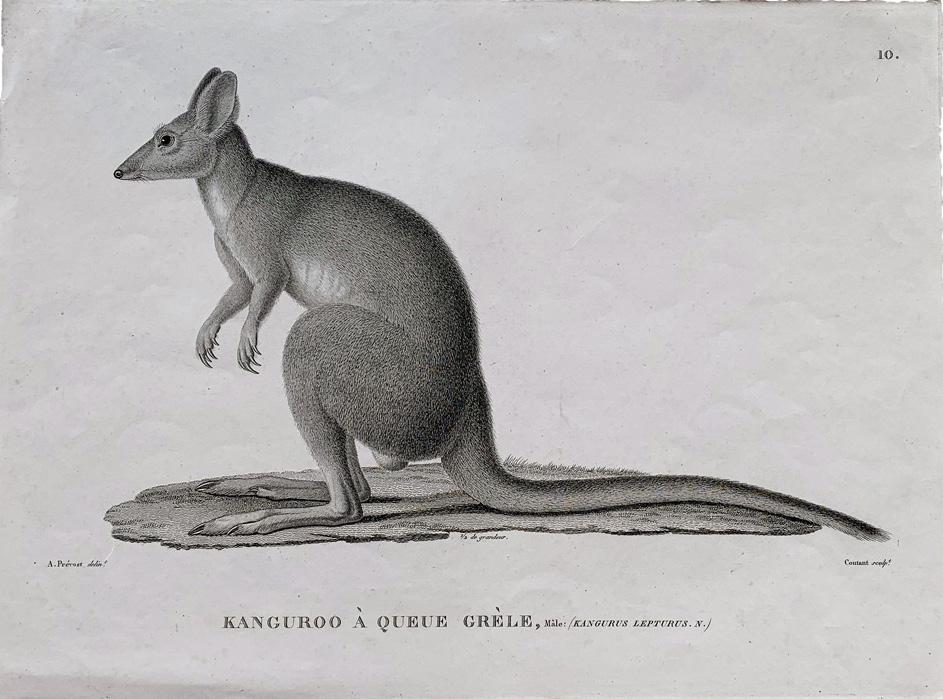
In the text of the Zoologie section Quoy and Gaimard equate the “petit kanguroo ou le kanguroo-rat des habitans du Port-Jackson” with those shown in the First Fleet accounts of Phillip (plate 47) and White (plate 60), and tell a sad story of the live specimen that they collected: “Notre individu a vécu quelques jours à bord de l’Uranie: il devint victime de la férocité d’un chien que nous avions pris aux îles des Papous, et qui l’étrangla au moment où il s’avançait vers lui en cherchant à le caresser…” [The dog ate our potoroo].
For the naming of different specimens collected of the potoroo, see Iredale and Troughton, p. 37, “Checklist of the mammals recorded from Australia”, in Australian Museum Memoir 6: 1–122, 1934.
$2600 [4505062 at hordern.com] see description and illustrations at
Quarto, engraved vignette on title-page and a half-page portrait of Michelangelo engraved by William Blake on final page of text; contemprary half dark calf andmarbled boards. London, Printed for J. Johnson, St Paul’s Church-Yard, 1801.
Fuseli, the Swiss-born painter Johann Heinrich Füssli, was known for his insightful and influential lectures on art, which he delivered during his time as a professor at the Royal Academy of Arts in London. His first three lectures, delivered in March 1801, appear here (“Ancient Art”; “Art of the Moderns”; and “Inventions”); they are generally seen as the best of his twelve such lectures, especially for the concentration of the first two on the history rather than techniques of art. All twelve lectures at the Academy were published some decades later in “Lectures on Painting, by the Royal Academicians” (London, 1848).
This rare printing is valuable for the striking full-length portrait of Michelangelo, “Ancora imparo” [“still learning”], with the wall of the Colosseum in the background, engraved by William Blake after Fuseli, while the vignette on the title-page, a classical depiction of a woman with head bowed and legs crossed, engraved by Francis Legat after Fuseli, is characteristic of Fuseli’s sometimes mysteriously doom-laden vision.

Provenance: Archibald Michie, 1813-1899; Australian politician who arrived from London in Sydney in 1839, later moving to Melbourne where he ultimately became attorney general of Victoria (with his signature on the title-page and a number of intelligent notes in margins). With the London binder’s ticket of McDonald and Duthie, St Martin’s Lane. Later blind-stamp of “H.T. Dwight bookseller near Parliament Houses”: Dwight “the colonial Quaritch”, started his business in Bourke Street in 1857. It continued after his death until 1872.
$1825 [5000741 at hordern.com] see description and illustrations at
British Institution for promoting the Fine Arts in the United Kingdom…
Quarto, 28pp., uncut; light pencil sketches on final page; original plain paper wrappers. London, W. Bulmer, 1817.
Very rare original documentation of works exhibited at the British Institution for Promoting the Fine Arts (usually known as the British Institution), which had been founded in 1806 as a private club for connoisseurs, and to exhibit the works of both contemporaries and Old Masters. Admission cost a shilling. These exhibition catalogues are only very rarely offered for sale, and are scarce in libraries. Works by both John Glover and William Westall are recorded in this catalogue for 1817, at which time both men were living in London. The catalogue records respectively two and four paintings by them, alongside works by Turner and Constable.
The notes on the artists appended to the catalogue give Glover’s address as Montague Square. Glover, who had begun exhibiting at the British Institution in 1810, showed two paintings in the annual exhibition for 1817, listed as ‘A Farm Yard’ and ‘Cephalis and Procris’ (Cephalis, properly “Cephalus”, was the mythological figure given a javelin that always hit its target by the goddess Eos, with which he accidentally killed his wife after a misunderstanding). To an Australian audience, of course, Glover’s importance lies in the work he did after his arrival in Hobart. Glover arrived in 1831, having followed his three sons, who had sailed for Van Diemen’s Land in 1829.
Also in the same exhibition are paintings by William Westall, who is listed as residing with his brother Richard, in either Bedford Square or Lake Grasmere. Westall was famous for his work as landscape artist on Matthew Flinders’ exploration of Australia aboard the Investigator, and it was the same brother Richard who restored many of his pencil-and-wash drawings after they were damaged in the wreck of the Porpoise. William had returned to London in 1805, where he established himself as an associate of the Royal Academy in 1812, and where he was commissioned to paint nine pictures to illustrate Flinders’ A Voyage to Terra Australis of 1814. The exhibition catalogue here lists four paintings by Westall, a ‘Distant View of Lake Windermere, from the Road between Troutbeck and Kirkstone’; a ‘View in the Garden of Corpus Christi College, Oxford’; ‘View from the garden of a Mandarin on the river beyond Canton in China’; and ‘Lake Windermere, with Stone Hall’. $1250 [3712441 at hordern.com] see description and illustrations at
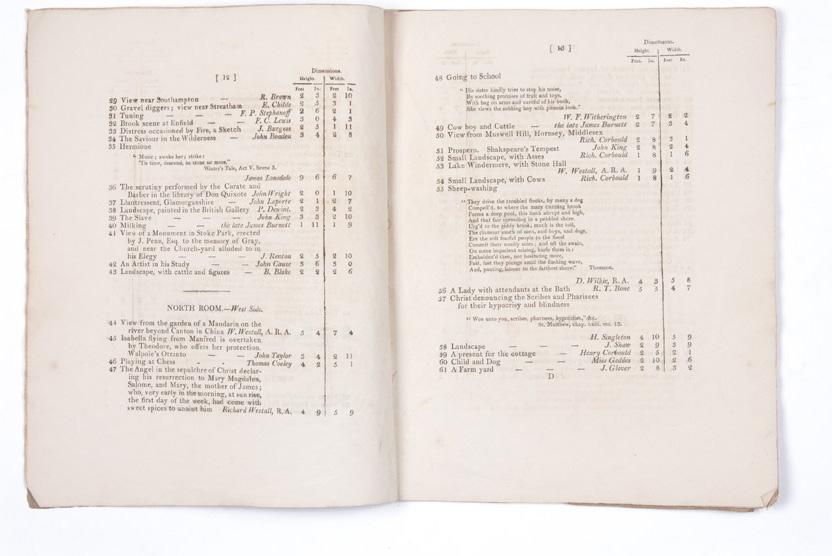
The Narrative of a Voyage of Discovery…
Quarto, with a large folding plate, a folding chart, a coloured plate and five other engravings; with the uncommon leaf headed ‘List of Encouragers’; contemporary half calf restored on original marbled sides. London, C. Raworth, 1803.

First edition: one of the most important of the early Australian coastal voyages. The Lady Nelson was the first ship to be built with sliding keels to facilitate the exploration of shallow waters. Grant brought the Lady Nelson out to Australia, in company with HMS Porpoise, in 1800 as a lieutenant in the Royal Navy. He sailed her through Bass Strait, the first to do so from the west and, on arrival at Sydney, he discovered that he had missed Flinders to whom he was to deliver the ship and was sent back to survey the south-western coast of the continent, a task in which he was assisted by Francis Barrallier. However, because of the lateness of the season, the survey, which took place from March to May 1801, concentrated on Bass Strait and the Victorian coast instead. The chart of Bass Strait here was the first to be published of the newly-discovered Victorian coast.
On his return to Sydney, Grant was sent to examine the Hunter River, and it was as a result of his report that Newcastle was established. Two engravings in this book illustrate the exploration by the Lady Nelson of the Hunter River: they were probably engraved after sketches by the colony’s first professional artist, John William Lewin, who accompanied the expedition. The finest is the handcoloured plate depicting the “Fringe Crested Cockatoo”, which is present here in particularly fine condition. There are also portraits of the Aborigines Pimbloy (an alternative spelling of Pemulwuy, the great warrior) “in a canoe of that country” and Bennelong.
Davidson, ‘A Book Collector’s Notes’, pp. 125-6 (‘rare and most desirable’); Hill, 718; Wantrup, 75.
Provenance: Private collection (Sydney).
$12,250 [4504286 at hordern.com] see description and illustrations at
Journal of Three Voyages along the Coast of China in 1831, 1832, and 1833…
Octavo, with an engraved frontispiece of Gützlaff’s residence in Canton and a folding map, a fine copy in a handsome early binding of polished calf, marbled edges and endpapers. London, Frederick Westley and A.H. Davis, 1834.

A scarce book. This is an enlarged version of the author’s “Journal of Two Voyages…” published the previous year, now adding Gützlaff’s third voyage “from the province of Canton to Leaou-Tung in Mantchou-Tartary; 1832-33”, as well as the Rev. Ellis’ essay on “the policy, religion, etc of China”.
Charles Gützlaff (1803-1851) went to the South Seas in 1826, in his early 20s, with the Netherlands Missionary society. He had medical training and a gift for languages and by 1830 had established himself and his young wife in Bangkok, moving on to China following the death of his wife and child. One of the voyages described here was aboard a vessel involved in the opium trade. He worked on a translation of the Bible in Chinese, published a Chinese monthly magazine, and was a chief negotiator during the opium war of 1840-1842.
Gützlaff’s book is also of Japanese interest: “As a member of the London Missionary Society, [Gützlaff] engaged in missionary work in the Orient, including in Thailand and China. This book is comprised of the records of his three voyages to areas off the coast of the East China Sea. During his second voyage, Gützlaff’s delegation departed the port of Macao, made a port call at Naha Port of Ryukyu Islands in August 1832, via a few other countries and regions including Taiwan and Korea. In the island, which was under the influence of the anti-Christian element of Japan’s seclusion policy at that time, Gützlaff managed to present three Bibles to the Ryukyu king. Gützlaff interacted with the Ryukyu people and observed their politics, religion, and language.
“Gützlaff later boarded the American merchant ship Morrison as an interpreter and visited the coast of Uraga and the Kagoshima Bay. Gützlaff was evicted when the ship was bombarded under the Japanese feudal government’s Edict to Repel Foreign Vessels (Morrison Incident, 1837), and thus failed to make a landing in Japan. He learned Japanese in Macao from Japanese castaways, such as Otokichi, and translated Yohane Fukuin No Den [The Gospel of St. John] (1837). This is known to be the oldest remaining Japanese translation of the Bible”. (Japan Foundation Library, online resource).
Cordier, 2111.
Provenance: James Blyth (with 19th century armorial bookplate, incorporating the motto “Persevere”).
$1850 [5000852 at hordern.com] see description and illustrations at
China Opened, or, a display of the… Chinese Empire…
Two volumes, octavo, folding engraved map with outline colouring, and a folding plate of Chinese characters; in a handsome contemporary binding of neatly diced dark green calf, spines decorated in gilt and blind between raised bands, double brown labels, marbled edges and endpapers. London, Smith, Elder and Co, 1838.

Soon after the period described by Gutzlaff in his Journal of Three Voyages, the missionary and traveller had been persuaded by William Jardine of Jardine, Matheson & Co. to interpret for their ships’ captains during coastal smuggling of opium, with the assurance that this would allow him to gather more converts. A gifted linguist, he mastered several Chinese dialects. He was also a central figure in the first opium war and funded his missionary work by drug-running. Although, as he has been described, he was ‘a cross between parson, pirate, charlatan and genius, philanthropist and crook’, he is regarded as the founding father of the Chinese Lutheran church.
Perhaps surprisingly, his writing is said to have influenced both David Livingstone and Karl Marx. It was after reading one of his missionary works that Livingstone decided to become a medical missionary, though the outbreak of the First Opium War made China too dangerous for that to happen. Marx went to hear him speak when Gützlaff was fundraising in Europe in 1850, and used his many writings as sources for his articles on China for the London Times and the New York Daily Tribune in the 1840s and 1850s, all of them anti-imperialist and anti-religion.
This speaks to the enigma that history suggests: recruited by Jardines despite being a missionary, involved with the opium business, Gützlaff did a deal of Christian good, training many Chinese, but nonetheless ending up fat rich and secular in Hong Kong - Charles Taylor in his “Five Years in China” reporting that by 1848 in Hong Kong Gützlaff had turned his back on being a missionary and had become a corpulent figure enjoying a large civil service salary. He left an enormous estate valued at £30,000 and was buried in Hong Kong Cemetery.
Cordier, 74, etc.
Provenance: James Blyth (with 19th century armorial bookplate, incorporating the motto “Persevere”). $3400 [5000853 at hordern.com] see description and illustrations at
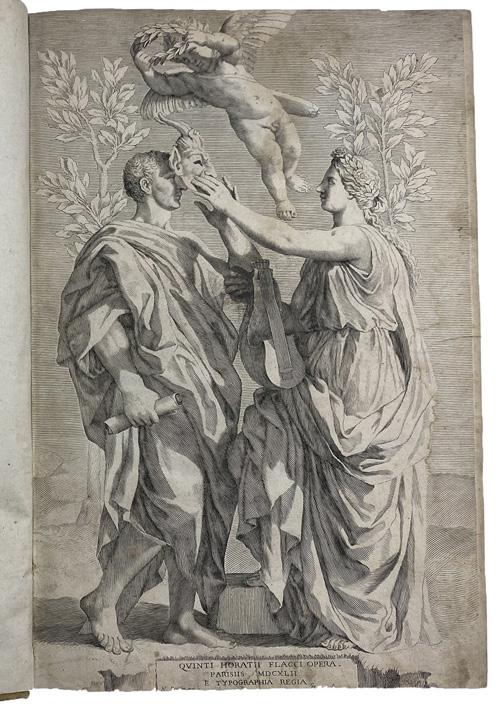
26. [HORACE] HORATIUS FLACCUS, Quintus.
Opera.
Folio, engraved allegorical title-page after Poussin, with 11 fine engraved headpieces and initials and four culs-delampe; with the half-title; final blank leaf discarded; early pigskin-backed glazed brown boards. Paris, Typographia Regia [Imprimerie Royale], 1642.
A grand edition of the works of Horace, set in a large typeface and with an elegant pictorial titlepage engraved by Mellan after Nicolas Poussin. Poussin’s drawing was owned by George III and is in the Royal Collections today (Blunt, The French Drawings in the Collection of His Majesty The King at Windsor Castle, Oxford and London, 1945, 249).
The French Royal Press at this time was renowned for its elegant and careful productions, particularly of the classics. As Moss, the bibliographer of classical authors, noted, this was “A very magnificent and rare edition; it is one of those which were executed at the Louvre”.
Brunet, III/317; Moss, II/15.
Provenance: Early presentation inscription dated 1679 on half-title.
$2200 [5000760 at hordern.com] see description and illustrations at
27. [HORACE] HORATIUS FLACCUS, Quintus.
[Opera, ed. Richard Bentley].
Quarto, with fine engraved frontispiece and vignette on title (title printed in black and red), contemporary panelled calf. Amsterdam, apud Rod. & Gerh. Wetstenios, 1713.
The improved second edition of Bentley’s celebrated Horace, preferred to the Cambridge first edition of 1711. Although controversial and the cause of much scholarly debate at the time, this important edition by the young Richard Bentley, eventually acclaimed by Dibdin as “Princeps criticorum”, was hailed for its hugely extensive notes but questioned for its “conjectures”.
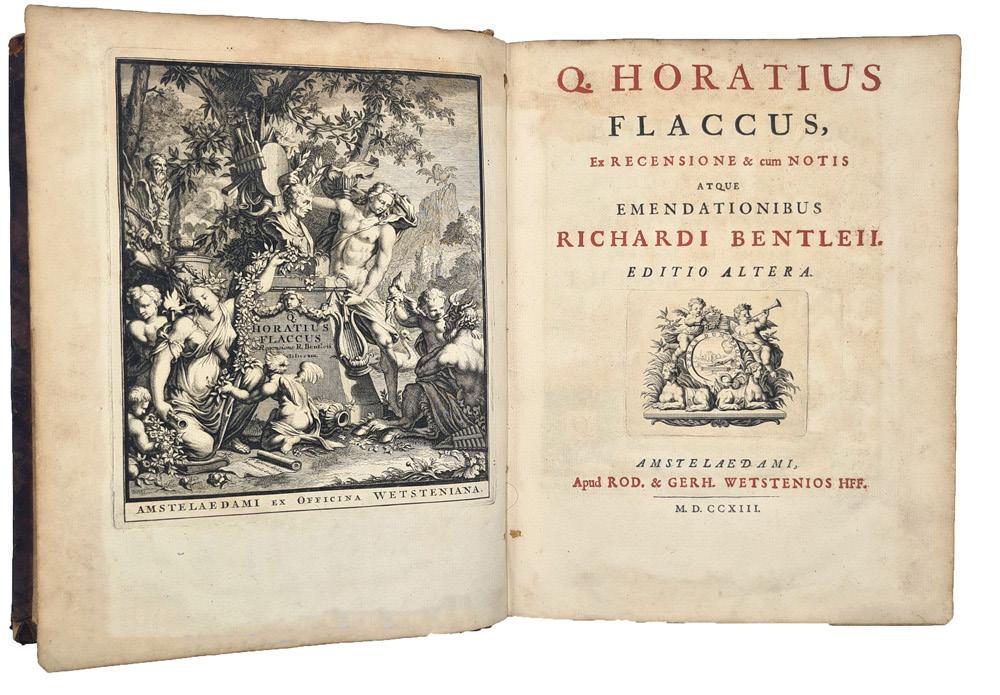
“A few days after its initial publication Thomas Hearne observed, on 29 January 1712, ‘Dr Bentley’s Horace is much condemn’d for the great Liberty he hath taken in altering the text’ (Remarks, 3.273), and pamphlet attacks soon followed. With more than 700 changes from the vulgate, this was indeed ‘unlike any edition of a Latin author ever before given to the world’ (Monk,1.316). Few of Bentley’s conjectures are accepted, but many of his accepted emendations began as conjectures before he found support in manuscripts consulted for his notes. Confident in his own divination, Bentley emended ‘anything inconsistent with the harmonious measures of classical poetry’ (Pfeiffer, 154). Yet, even where his solutions are wrong, Bentley’s grasp of textual problems and the learning he brings to bear on them are quite extraordinary. The much quoted note on Odes, book 3, ode 27, line 15 ‘To us reason and common sense are better than a hundred codices’ significantly continues, ‘especially with the added testimony of the old Vatican codex’“ (DNB).
Brunet II, 318f. (“une des meilleures éditions que l’on ait de ce poëte… on préfère l’édition d’Amsterdam, 1713”); Dibdin II, 101-105.
Provenance: Edward Henry Cooper (1827-1902), Landowner, Lieutenant-Colonel, Grenadier Guards, and Conservative politician; MP for County Sligo (armorial bookplate as “Colonel Cooper”).
$1500 [5000761 at hordern.com] see description and illustrations at
The Naturalist’s Library.
Complete set of 40 volumes, small octavo, each volume with portrait frontispiece & engraved and printed title-page to each volume, and some 1248 handcoloured engraved plates (see note below), making a total of 1328 plates; in a fine nineteenth-century half calf binding, banded spines with double crimson and green labels. Edinburgh, Lizars; and London, Bohn, 1835 to 1866.
An attractive well-bound set of this mid nineteenth-century natural history encyclopaedia. Each volume also features a frontispiece and introduction devoted to the life of an eminent naturalist, with good biographies for example of Sir Joseph Banks and François Péron, as well as John Ray, Thomas Pennant and Thomas Bewick. The Naturalist’s Library was an immensely successful publication, and offered the general public a beautiful and informative encyclopaedia of the natural world. Jardine wrote 15 of the volumes himself, and contributed many of the biographical introductions in the series. The work is renowned for the quality of the steel engravings by William Home Lizars, Jardine’s brother-in-law.

Sir William Jardine was born in 1800 and developed a keen interest in natural history during his childhood at Jardine Hall, a magnificent estate in Dumfriesshire. A gifted anatomist, Jardine travelled widely in search of specimens for his private museum, beginning with a three year investigation into the life cycle of British salmon and trout. Further adventures took him throughout continental Europe and later the Caribbean. Through these travels and his ceaseless correspondence with fellow naturalists across the globe, Jardine’s museum became one of the significant British private natural history collections of the era, boasting over 6,000 species of birds alone.
Jardine’s Library includes a rich representation of Australasian species, with one volume entirely devoted to Australian fauna, and including 30 plates depicting possums, marsupials, kangaroos, native mice, koalas, platypus and the now extinct Tasmanian Tiger. Descriptions and illustrations of other Australian species are scattered throughout the entire work, for example a volume devoted to dogs includes the ‘New Holland Dingo’ with a striking coloured plate alongside a fine engraving of the skull of the dingo compared to that of a jackal. In particular, the fourteen volumes of the series devoted to birds are well stocked with Australian species, and are especially good on parrots, with splendid illustrations of cockatoos, galahs and lorikeets.
Complete sets of this work are uncommon; Ferguson, for example, records only scattered volumes from the series (see 2314a, 3622b, 2766b, etc.). Like other examples, this set is composed of a mixture of volumes from the original Edinburgh edition and the London Bohn version, so spans some thirty years. As often, some of the plates do not exactly correspond to contents leaves, occasionally having too many and other times too few as against the printed contents in each volume: this set contains altogether 1328 plates of a possible 1327 (according to the contents pages) or more likely 1330 (this figure including a frontispiece and engraved title to each volume).
$9850 [4504064 at hordern.com]
see description and illustrations at
29. [LA PEROUSE] [VINATY, J.A].
Éloge de la Pérouse…
Octavo, 46 pp., in recent blue paper boards with morocco label. Paris, Firmin Didot, 1823. Very rare eulogy to La Pérouse published some thirty-five years after the disappearance of his two vessels, and a scant three years before the clues to the loss of the Astrolabe and the Boussole were discovered by the sandalwood trader Peter Dillon.
Vinaty (sometimes ‘Vinati’) prepared the work for the Académie des Jeux-Floraux of Toulouse, where the eulogy won their prize l’Eglantine d’Or. The work is not only testament to the enduring importance of La Pérouse in the French-speaking world, it is also an interesting document of its time, because Vinaty shows a willingness to skip over the years of the Revolution and the rule of Napoleon. He is at pains to re-assert a continuity with the glory of France under Louis XVI, in the process presenting La Pérouse as a truly great French hero, but also as one capable of honouring the memory and achievements of Cook (a lengthy passage, for instance, praises La Pérouse for raising a suitable memorial above the tomb of Cook’s successor Captain Clerke in Kamchatka). Throughout, the tone is pure Restoration, underlined by his quoting from the great exile writer Chateaubriand.

The work’s rarity is borne out by Ferguson, who first located a copy in the Edward Weber Allen collection in California in time for the addenda to volume II of his bibliography; the copy in the State Library of New South Wales was added with a revised note to the full Addenda volume of 1986. The work is also noticed in McLaren’s Lapérouse in the Pacific, who added a copy in the Bibliothèque Nationale. Otherwise, Vinaty’s work is not noted in many standard references (it is a surprising omission from Forbes’s Hawaiian National Bibliography); nor is it listed in important collections such as Kroepelien and Hill.
Ferguson, 923b (rev); McLaren, ‘Lapérouse in the Pacific’, 875; not in Forbes.
$3500 [3902034 at hordern.com] see description and illustrations at
Rélation du Voyage à la Recherche de La Pérouse…
Two volumes, quarto, and folio atlas; text volumes uncut; the atlas with engraved title, folding chart of the voyage and 43 engraved maps, and plates; text in marbled papered boards, atlas in contemporary quarter calf with marbled paper sides. Paris, H. J. Jansen, 1800 [Atlas volume dated 1817 on title-page].
The superbly illustrated narrative by the naturalist on the d’Entrecasteaux expedition, in which Australia was fully circumnavigated, if sometimes at a distance, and the islands surrounding investigated for traces of La Pérouse. Jacques-Julien Houtou de Labillardière (1755-1834), was a botanist and doctor of medicine, who had travelled widely in the Middle East: he was just finishing up his important botanical study of Syria when he was appointed to the d’Entrecasteaux voyage. He remains an important figure in early Australian science as the author of the first extensive monograph on Australian botany.
The voyage spent many months on the coasts of Western Australia, just a year after Vancouver’s visit, and made two long visits to Tasmania, charting, botanising and exploring the coasts. The visits are remembered in numerous place names, most notably Recherche Archipelago and Recherche Bay, named for the expedition’s ship. Labillardière’s account is one of very few eighteenth-century accounts of Australian exploration, and the only major French account of the continent in the early settlement period to be published in the same century. The important narrative based on the commander d’Entrecasteaux’s papers did not appear until 1808, once the First French Republic had been well established.
In this set the Atlas volume is present in the 1817 reissued version, from the same printing as its appearance in 1800 but with a new title-page. Published on its own, it may well have been produced to accompany text volumes that remained in print from the earlier edition. The publication is noted (without particular comment) by the McLaren bibliography and recorded by Ferguson from copies in the Mitchell Library and the Tasmanian parliamentary library.
The work is particularly interesting for its descriptions (and illustrations) of Tasmania, Tonga, New Caledonia, and New Guinea, and the atlas contains outstanding views of these areas, their inhabitants, and native artefacts by the official artist Piron. Included is the famous engraving of the black swan. the first large depiction of the exotic Australian bird. Fourteen superb botanical plates, all by or produced under the direction of Redouté, the most famous of all botanical artists, include two of Eucalypts and two of Banksias. There are three fine bird studies by Audibert.
see description and illustrations at

La Marine au XIXe siècle par Lebreton…
Oblong album measuring 245 x 335 mm., title-page and twelve tinted plates, fine in original decorated papered boards. Paris, Théodore Lefèvre, circa 1856.
A particularly attractive French lithographic album of marine scenes by a seasoned voyage artist. As the title boasts, Louis Le Breton served as artist on Dumont d’Urville’s second voyage to the Pacific and Antarctic during 1837-1840. He was taken on in 1837 as assistant surgeon on board the Astrolabe. Since he showed a talent for drawing, Ernest Goupil, the official artist on board, took him under his wing and began to train him as a painter. When illness struck the crew of both ships in 1838, Goupil became one of the victims, dying in January 1840 in Hobart Town. Dumont d’Urville then appointed Le Breton as the expedition’s artist; on their return to Paris the drawings of both Goupil and Le Breton were used for the magnificent lithographs in the huge publication of the official account of the voyage.
From 1845 to 1847 Le Breton took part in an expedition to Madagascar, and thereafter devoted himself to depicting marine subjects for the French Navy, specialising - as here - in lithographs depicting naval forces, ships and boats, sea landscapes and ports. He transferred to the Department of Maps and Charts in Paris, where he remained until his death in 1866.

The album comprises thirteen lithographic plates, including the romantic pictorial title-page depicting mariners wrecked upon the rocks. Five scenes depict the French and British at sea during Crimean War engagements of 1854; namely Friedland in consort with a British warship entering the Bosphorus, the arrival of the Anglo-French fleet at Kalamita, bombarding the defences of Sevastopol, and the British gunboat Agamemnon tackling a gale in Sevastopol harbour. The last Crimean lithograph is an especially dramatic rendition of the port of Balaclava viewed from the clifftops with archaic ruins in the foreground. Other marine scenes of interest include Galilée, a fully rigged naval paddle-steamer, Brasilian clipper l’Impératrice rounding the Cape, an American barque at La Havre and the enormous gunboat Napoleon half rigged, resting at anchor.
Polak, 5516, noting only 10 plates.
$3750 [4202828 at hordern.com] see description and illustrations at
Narrative of the Voyage of H.M.S. Rattlesnake…
Two volumes, octavo, with engraved folding map and 13 lithographed plates after T. Huxley and others as well as many text illustrations; a fine copy in an early binding of half polished calf, spines gilt in compartments, double labels. London, T. & W. Boone, 1852.
First edition: “a very important voyage of exploration and scientific research” (Ferguson). This was the last, and today is the most difficult to find, of the great exploration journals published by Boone during the heroic age of Australian exploration.
John MacGillivray served as the chief naturalist on the Rattlesnake, part of the important series of hydrographical voyages undertaken by the Admiralty in the late 1840s to chart the Great Barrier Reef and north coast, and the southern coast of New Guinea. The Rattlesnake continued the work that began with Lort Stokes on the Beagle and was continued by Blackwood on the Fly and Bramble. The ship’s complement was distinguished by the presence of the naturalist, T.H. Huxley, and the marine artist, Sir Oswald Brierly. A number of the plates here are after drawings by Huxley.

MacGillivray’s books is also of value for its reprinting of William Carron’s extremely rare narrative of the tragic Kennedy expedition. It was the Rattlesnake that transported Kennedy and his large party to their point of departure on the Queensland coast. The statement made by Jackey Jackey, the remarkable figure who was Kennedy’s Aboriginal servant, is also included.
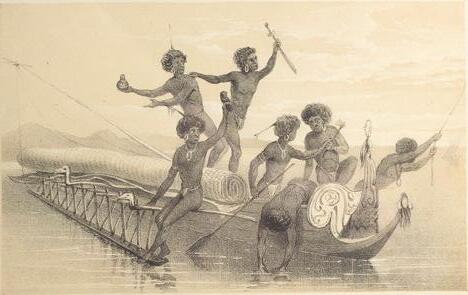
Ferguson, 11972; Hill, 1060; Wantrup, 145.
Provenance: R. David Parsons (American collector, with book-label); Eric Stock (Melbourne collector, with bookplates).
$14,000 [5000708 at hordern.com] see description and illustrations at
Viscount Melbourne.
Mezzotint measuring 305 x 230 mm. (plate size). London, Hodgson & Graves, 1839.
A beautifully executed mezzotint portrait of William Lamb, second Viscount Melbourne, after whom the capital city of Victoria was named in 1837. Although printed in 1839, at the height of Melbourne’s career and while he was serving as Prime Minister of Great Britain, the mezzotint is based on a youthful portrait of the great statesman by Sir Thomas Lawrence R.A.

The city of Melbourne grew from humble beginnings, when John Batman explored the Port Phillip Bay area against the express wishes of Sir Richard Bourke, Governor of New South Wales. Within two years Bourke was forced to acknowledge the rapidly growing settlement which he named in honour of Viscount Melbourne in 1837. In doing so Bourke replaced a variety of names for the fledgling settlement including Bearbrass, Bearport, Glenelg and Batmania (so called after John Batman).
Largely due to the gold-rushes of the mid nineteenth-century Melbourne became one of the most prosperous and fastest growing cities of the British Empire.
$850 [4007937 at hordern.com]
see description and illustrations at

Notes of a Voyage from New South Wales…
Octavo, photographic frontispiece, eight lithograph plates and four folding lithograph maps and another map in the text; fine bright green original cloth, gilt. Glasgow, privately printed, n.d. but, 1876.
A presentation copy from the editor, James R. Napier, to A.G. MacDonald (dated 7 August 1876).
Francis Napier joined the South Australian Government expedition under Captain Cadell. They were searching for suitable sites for settlement on the north coast of the state (now the Northern Territory).
The expedition departed from Newcastle, New South Wales calling at Brisbane and travelling on to Cape York Peninsula. From Cape York it crossed the Gulf of Carpentaria to the Liverpool River, surveying that river and exploring the coast for about one hundred miles east and west of it. The expedition then returned to Burke Town on the Albert River, at the head of the Gulf of Carpentaria, and passing through Cadell Strait, and along the west coast of the Gulf, remaining some time at Maria Island… It discovered the entrance to the Roper River, from the Roper it returned to the Liverpool river, thence sailing westwards to Mount Norris Bay, Adam’s Bay, and Victoria River, in search of fuel, food and water.
The Notes outline the discoveries of the voyage including the entrance to the Roper River. These notes - which provide the only public account of the expedition - were compiled from Napier’s journal by his family and privately printed in Glasgow following his death in 1875.
A beautiful copy of a very rare book.
Ferguson 13058
Provenance: With the bookplate of Tristan Buesst
$4750 [3005341 at hordern.com]
see description and illustrations at
and George BENNETT.
Two pieces on the platypus, by Owen and Bennett.
Quarto, with two lithograph plates illustrating the Owen article and one for the Bennett article; untrimmed, with large margins, in plain wrappers. London, Zoological Society, 1835.
Two important and early scientific articles on the platypus, published consecutively in the Transactions of the Zoological Society This first volume of the Society’s journal was published in 1835, containing papers communicated as early as 1833. The two articles here were communicated in 1834.

A fierce and protracted debate about the platypus was taking place in the 1820s and 1830s, with proponents including Henri Blainville, Sir Everard Home, Baron Cuvier, and the anatomist Johann Friedrich Meckel who had published the first monograph on the platypus (Leipzig, 1826). Richard Owen became involved in examining the structure and particularly the mammary glands of the monotreme in the early 1830s and when his friend George Bennett left England in 1832 he was determined to find a solution to the questions that Owen had raised. Bennett’s travels in Australia allowed him to make firsthand observations about the platypus’s habitat, feeding habits, locomotion, and nesting behaviour. He sent numerous natural history specimens back to Owen in London.
Owen’s work here “On the young of Ornithorhynchus paradoxus” sheds light on the developmental stages and physical characteristics of platypus offspring, while Bennett’s “Notes on the Natural History and Habits” focuses on the natural history and behaviour of the mammal. Bennett’s popular books Wanderings in New South Wales (1834) and Gatherings of a Naturalist in Australasia (1860) both contain observations and descriptions of the platypus, the latter title with a classic account of the mammal in which Bennett refers to ‘my friend Mr Owen’ and Owen’s identification of the mammary glands of the platypus.
$2100 [5000875 at hordern.com] see description and illustrations at
Preliminary Catalogue of Fixed Stars…
Large quarto, 252 x 218 mm, pp 20, [ii], XXV; stab-sewn in the original blue-grey limp paper wrappers, with a presentation inscription on the front wrapper; preserved in a fitted quarter morocco bookform case. Hamburg, Printed for Perthes and Besser, 1832.
Very rare, a pioneering foundation work of Australian science and important in the history of world astronomy: the first Australian star catalogue, this copy inscribed by the author to Alexander Dallas Bache (1806–1867), scientist and educator, the great-grandson of Benjamin Franklin. This elusive book was probably printed in very small numbers for a specialist audience; just two copies are recorded in Australian libraries (NLA and SLNSW).

Christian Carl Ludwig Rümker (1788-1862), German astronomer, arrived in England in 1809, working for the East India Company and the merchant navy, before being press-ganged into the Royal Navy in 1813. Over the next few years he began making observations, including publishing the results of work he did at Malta. Recommended with an introduction - by Captain Peter Heywood, the involuntary participant in the Bounty mutiny - to the incoming Governor of New South Wales, Thomas Macdougall Brisbane, himself a keen astronomer, he arrived as part of the official party in 1821, beginning work at Brisbane’s Parramatta observatory, near Sydney, where he made several discoveries including “Encke’s Comet”. A bitter disagreement with Brisbane led him to resign his post, and to retreat to his new property at Picton, “Stargard”.
In 1826 he returned to Parramatta at the behest of Alexander Macleay, and was appointed government astronomer in December 1827, the first person to hold that title. He returned to London at the end of the decade, but another quarrel, this time with the president of the Royal Astronomical Society, Sir James South, led to Rümker finally being dismissed from British service and returning to Hamburg. Still working as an astronomer, at some point he became reconciled to Brisbane, as is shown by the present work’s dedication to him as “late Governor in Chief of Australia and Founder of the Observatory at Paramatta [sic]”.
Rümker’s later career was prolific, publishing scores of papers and being honoured with many fellowships, and continuing to work on his trail-blazing Parramatta observations. He died at Lisbon in 1862. “When awarding the gold medal of the Royal Astronomical Society to Rümker, the astronomer royal, Sir George Biddell Airy, said that Rümker’s dismissal was ‘the greatest misfortune that happened to Southern Astronomy’” (ADB).
Provenance: Inscribed by Rümker on the front wrapper “Professor A[lexander] D[allas] Bache with the author’s Comp[limen]ts”; at one time with Philadelphia Rare Books, USA.
$19,500 [5000809 at hordern.com]
see description and illustrations at

37. SMITH, James Edward.
A Specimen of the Botany of New Holland…
Quarto, with 16 finely coloured engraved plates; half calf, marbled boards, entirely uncut. London, James Sowerby, 1793. The first separately published book on Australian botany. The Specimen of the Botany of New Holland contains the first illustrations of a number of Australian species, including the waratah. According to a note in the preface the drawings on which the fine hand-coloured plates were based were done in the colony by John White, the Surgeon-General, who was a keen amateur natural history artist and collector. White’s own Journal of a Voyage to New South Wales, published in 1790, celebrated the new colony’s ornithology in particular.

The period of European settlement in Australia was also a time of fine book production in Europe; the wide public interest in natural sciences meant that the illustrated books published during the period were not only factual but often exceptionally beautiful. The Preface here states that this work is “An Attempt to make the Public acquainted with some of the productions of a country of which they have lately heard so much, and in which they are now so deeply interested… the present work must be considered… a Specimen of this mine of botanical novelty”. The illustrations were prepared not only from drawings supplied from Sydney but also from the “most copious and finely preserved collection of dried specimens…” that came with them from New South Wales.

James Edward Smith was one of the leading naturalists in England and the author of several outstanding botanical books. In 1788 he founded, and was the first President of, the Linnean Society which became a meeting place for botanists and a significant reference source as Smith had, for the Society, acquired the collections and library of the famous Swedish naturalist, Linnaeus. Sir Joseph Banks was a close colleague of Smith, and James Sowerby (1740-1803), the artist of these superb plates, was one of the foremost botanical artists, who exhibited frequently at the Royal Academy. The collaboration between these great naturalists ensured that Australia’s first illustrated flower book was among the finest of the period.
This is a lovely copy of a rare and important book.
Ferguson, 170; Nissen, 1861; Sitwell and Blunt, ‘Great Flower Books’, p. 76.
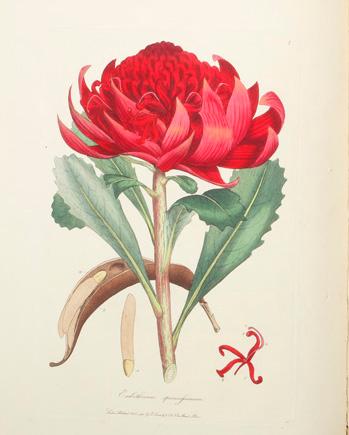
$58,500 [5000707 at hordern.com]
see description and illustrations at
King David in Prayer.
Arched miniature on vellum depicting King David kneeling in prayer, 91 x 65mm., set in elaborate hand painted illuminated border on three sides; 4-line illuminated initial D (of “Domine” - O Lord), eight lines of gothic text on the other side; mounted. Southern France, circa 1475.
A superb late fifteenth-century miniature of King David from a fifteenth century French Book of Hours. The image of David, with his harp, kneeling in prayer, introduces the opening of the Seven Penitential Psalms, of which King David was traditionally identified as the author. The quality of the miniature is very fine; the king’s face, drapery and the naturalistic landscape in which he kneels are all delicately rendered. The intense colours, differentiated landscape, and the elaborate border decoration of acanthus and gold leaves and flowers on swirling hairline stems all point to an artist in southern France.

The group of Seven Penitential Psalms (6, 32, 38, 51, 102, 130, and 143) is particularly expressive of sorrow and repentance for sin, and was first given the name by Saint Augustine of Hippo: the title was originally only associated with the fifty-first psalm, ‘Miserere’, the psalm which was conventionally used to close daily morning service.
King David also appears here as a model of penitence: after his commission of the dual crimes of adultery, with Bathsheba, and the murder of her husband Uriah, by sending him to be killed in battle, David was rebuked by the prophet Nathan and reprimanded by God. He repented and withdrew to live in exile, devoting himself to prayer.
The miniature dates from the end of the fifteenth century, and is a reminder that even after the invention of moveable print and the Gutenberg revolution, the older tradition of manuscript transmission was still the dominant medium of the period, and that the traditions of artistry associated with the illumination of manuscripts were still of the highest quality.
$3850 [3108951 at hordern.com] see description and illustrations at
Drawing of a lion…
Original drawing, 170 x 100 mm, graphite and sepia on card; signed lower left William Strutt; mounted and framed. Paris, at the Jardin des Plantes, 1895.
William Strutt (1825-1915) was born in Devon, England in 1825. For a period of his younger life he lived in France, returning there in the late 1830s to study painting at the Ecole des Beaux-Arts, spending much time in the Louvre with the works of Raphael, which would remain a lifetime influence. In 1850 he sailed to Melbourne where he became a founder of the Fine Arts Society (later renamed the Victorian Society of Fine Arts) and exhibited at the Melbourne Exhibition in 1854.
Strutt excelled as an animal painter. On his return to England in 1862, and influenced by the PreRaphaelites, he came to “regard the lion as the greatest symbol of nobility and strength” (Marjorie J. Tipping, in the Australian Dictionary of Biography, online resource). So entranced was he with wild animals that he travelled to North Africa to study them in their native habitat.
This is a delightful group of drawings which together form a study of a lion at the Jardin des Plantes, the famous zoo in the centre of Paris. Captioned “Jardin des Plantes”, it bears several inscriptions including the dates of “Paris May 23rd 1895” and “zoo August 7th/ 95”. To the left he writes under the lion’s face “cast of whiskers depressed” and to the right “the eyeball nearly melts away… in the light”. Strutt’s close and intimate study of several aspects of this lion demonstrates his outstanding skills as both a draughtsman and a superb animal artist. Strutt exhibited 23 times at the Royal Academy and was a member of the Royal Society of British Artists.
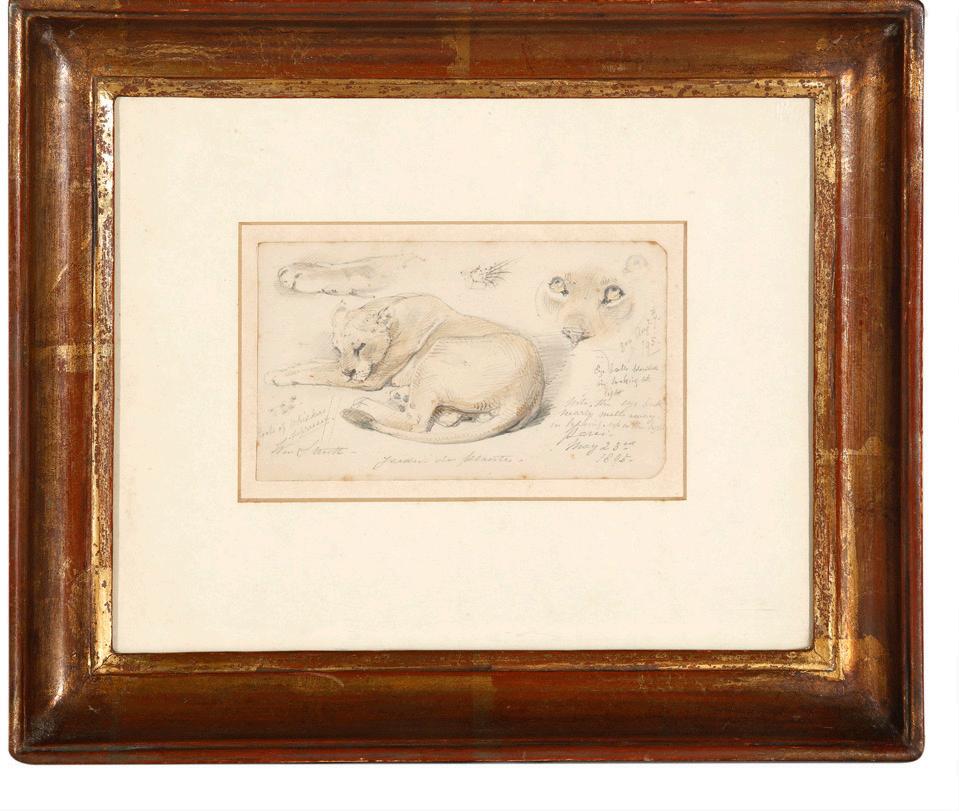
Provenance: Private collection (New South Wales).
$3400 [5000823 at hordern.com] see description and illustrations at
40. SYDNEY JEWISH SABBATH SCHOOL. COHEN, Maurice Abraham.
Gold “Vesta” matchbox inscribed “A souvenir from the Sydney Jewish Sabbath School, 1905”… 9 carat gold matchbox, 15 gr; 45 x 30 mm; monogrammed on the back with interwoven letters “M.A.C.”. Sydney, 1905.
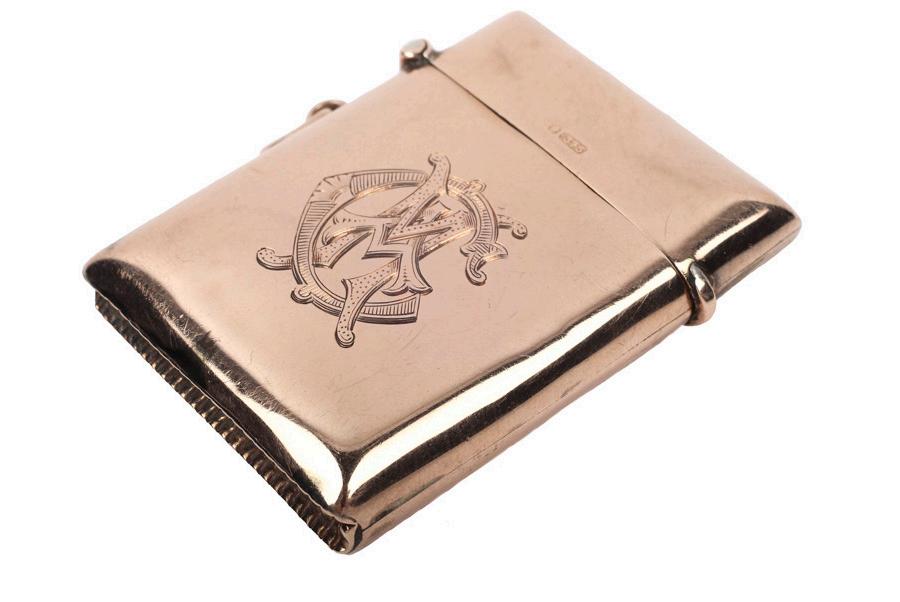

A remarkable memento of the pioneer Jewish educator Maurice (Moses) Abraham Cohen (18511923). Objects from the Australian Jewish community at the start of the 20th century (prior to the great waves of Jewish immigration) are very scarce. The monogrammed initials on this attractive presentation piece identify it as a gift from the Sydney Jewish Sabbath School to M.A. Cohen, the School’s first principal.
Born in Ukraine to a Sephardic family, Cohen was a talented linguist. Educated in England, after spells in India and Afghanistan he travelled to Australia in 1887 where he took up a role as the first headmaster of the Jewish Sunday School, just then established in Sydney within the Great Synagogue, Australia’s finest synagogue. He went on to become head of the NSW Jewish Board of Education. At one time he was editor of Sydney’s first Jewish weekly newspaper the Australian Jewish Weekly, as well as a lecturer on Hebrew at a number of theological colleges in Australia.
Cohen was one of the first European Australians to call attention to the plight of the Australian Aborigines and argue for compensation and land rights, even risking his position as editor of the Australian Hebrew Newspaper with his fiery opinion pieces on the subject. He also argued for increased non-discriminatory immigration drawing from all cultures and vehemently opposed the White Australia Policy. (The Australian Jewish Historical Society, “The First Jewish Educator for Sydney”: online resource).
So-called “Vesta” cases, named for the Roman goddess of fire and the hearth, are small portable boxes made to contain matches and keep them dry. More commonly made of tin or sometimes enamel or silver, with later examples sometimes carrying advertising or being highly decorated, gold examples from this period represent a high standard and were very suitable for presentation pieces; this fine example was perhaps made to join a pocket watch on its gold chain.
$6775 [5000696 at hordern.com] see description and illustrations at
On the Phenomena of Variation and Geographical Distribution as Illustrated by the Papilionidae of the Malayan Region…
Quarto, 72 pp., with eight lithographic plates by Day and Son after J.O. Westwood; uncut and unopened, in later plain wrappers. London, Longman, Green, et al., 1865.
The rare first printing of one of Alfred Russel Wallace’s most significant papers: his important text on butterfly variation on the Malay Peninsula, illustrated with eight full-page lithographic plates. Of this paper Darwin wrote, “I cannot conceive that the most firm believer in species could read it without being staggered. Such papers will make many more converts among naturalists than long-winded books such as I shall write if I have the strength” (Epsilon WCP1868).
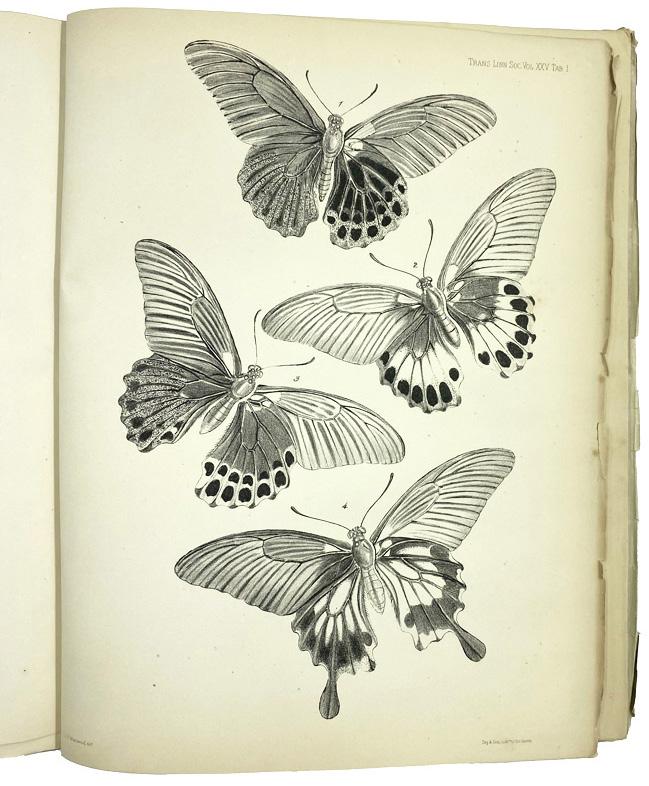
In this paper, read before the Linnean Society of London on 17 March 1864, Wallace presented detailed evidence of evolution occurring in nature. It contained some of his most important early observations and conclusions concerning mimicry, polymorphism, and protective colouration. One of Wallace’s most frequently cited works, it was based on data collected during his research on the Malay Peninsula from 1854-62, during which he devised his own theory of natural selection independent of Darwin, later published in his Malay Archipelago (1869). Wallace’s Malay research “alone would have established him as one of the greatest English naturalists of the age” (DSB).
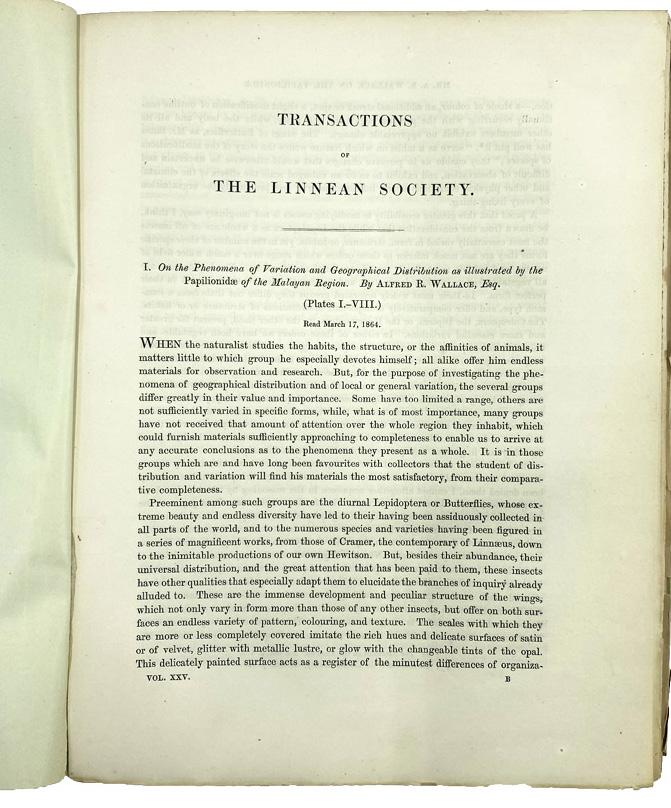
We have traced just two copies of this rare offprint sold at auction in modern times.
$4850 [5000874 at hordern.com] see description and illustrations at
“THE WINGS OF BUTTERFLIES… SERVE AS A TABLET ON WHICH NATURE WRITES THE STORY OF THE MODIFICATION OF SPECIES”Jeremy Norman, Evolution collection, Sotheby 1992, 395.
HORDERN HOUSE hordern.com
The Complete Angler. Or the Contemplative Man’s Recreation.
Two volumes, large and heavy octavo, 14 fine engraved plates, with many additional textual engravings; in a beautiful contemporary binding of half brown morocco over marbled boards, top edges gilt, cloth slipcase. London, Nattali and Bond, 1860.
This very handsome edition of the angling classic is the second Nicolas edition, reprinted from Harris Nicolas’s Pickering edition of 1836, which is considered one of the most beautiful and thorough fishing books ever published.
This version is richly illustrated with a total of 61 plates and vignettes, after Stothard, Inskipp, and Hassell. The text is taken from the fifth edition of the Compleat Angler of 1676, which was the last revised by Walton, but it also footnotes the text of all four earlier editions. Also included are thorough memoirs and notes of both Walton and Cotton.

$2850 [3002974 at hordern.com]
see description and illustrations at
Coigney, 78; Horne, 77; Lowndes, p. 2829; Oliver, 75; Wood, p.95.